


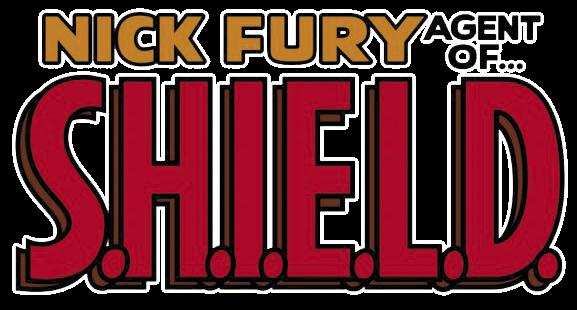
No.141 February2023 $10.95 Nick Fury, Agent of S.H.I.E.L.D., Hydra, and related characters TM & © Marvel. All Rights Reserved. SPIES AND P.I.S ISSUE! ™ MARK EVANIER Crossfire column • MAX ALLAN COLLINS & TERRY BEATTY Ms. Tree interview WILL EISNER’S John Law • Checkmate • Tim Trench • Mike Mauser & more …PLUS A HISTORY OF HYDRA! ™ 1 8 2 6 5 8 0 0 4 8 9 7
IN MEMORIAM: Tim Sale 2
FLASHBACK: Sgt . Fury and His Howling Commandos in the Bronze Age . . . . . . . . . . 3 The final days of the future S.H.I.E.L.D. director’s battle comic
BEYOND CAPES: Whatever Happened to Tim Trench? 7 A casebook of capers starring Denny O’Neil’s DC Comics gumshoe
BACKSTAGE PASS: Nick Fury, Agent at Large . . . . . . . . . . . . . . . . . . . . . . . . . . . . . . . 11 Marvel creators go behind the scenes of S.H.I.E.L.D.’s Bronze Age missions
UNKNOWN MARVEL: Nick Fury in Britain 27 The S.H.I.E.L.D. agent’s adventures in Marvel UK comics
FLASHBACK: Mike Mauser, Private Eye . . . . . . . . . . . . . . . . . . . . . . . . . . . . . . . . . . . . 31 This mousey detective graduated from an E-Man appearance to his own feature
WHAT THE--?!: Encyclopedia Brown . . . . . . . . . . . . . . . . . . . . . . . . . . . . . . . . . . . . . . 37 Did you know that this schoolboy crime-solver had a comic strip?

PRO2PRO: Max Allan Collins and Terry Beatty’s Ms Tree 40 The hard-case heroine’s history, in an interview with her creators
OFF MY CHEST: Caught (Happily) in the Crossfire . . . . . . . . . . . . . . . . . . . . . . . . . . . 51
Guest columnist Mark Evanier recalls the joys of his collaborations with Dan Spiegle
BRING ON THE BAD GUYS: Hail Hydra! . . . . . . . . . . . . . . . . . . . . . . . . . . . . . . . . . . . 55
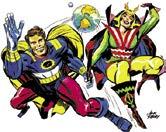
A villain history of the many-armed criminal cartel
ONE-HIT WONDERS: Will Eisner’s John Law, Detective 67 Discover the Spirit-ed history of this little-known character
FLASHBACK: The Secret World of Checkmate . . . . . . . . . . . . . . . . . . . . . . . . . . . . . . 70 The explosive story of DC Comics’ super-espionage team
BACK TALK: Reader Reactions . . . . . . . . . . . . . . . . . . . . . . . . . . . . . . . . . . . . . . . . . . . 78
BACK ISSUE™ issue 141, February 2023 (ISSN 1932-6904) is published monthly (except Jan., March, May, and Nov.) by TwoMorrows Publishing, 10407 Bedfordtown Drive, Raleigh, NC 27614, USA. Phone: (919) 449-0344. Periodicals postage paid at Raleigh, NC. POSTMASTER: Send address changes to Back Issue, c/o TwoMorrows, 10407 Bedfordtown Drive, Raleigh, NC 27614.
Michael Eury, Editor-in-Chief. John Morrow, Publisher. Editorial Office: BACK ISSUE, c/o Michael Eury, Editorin-Chief, 112 Fairmount Way, New Bern, NC 28562. Email: euryman@gmail.com. Eight-issue subscriptions: $97 Economy US, $147 International, $39 Digital. Please send subscription orders and funds to TwoMorrows, NOT to the editorial office. Cover artwork by Dave Johnson. Nick Fury, Agent of S.H.I.E.L.D. and Hydra TM & © Marvel. All Rights Reserved. All editorial matter © 2023 TwoMorrows and Michael Eury. Printed in China. FIRST PRINTING
Volume 1, Number 141 February 2023
PUBLISHER John Morrow DESIGNER Rich Fowlks COVER ARTIST Dave Johnson COVER DESIGNER Michael Kronenberg PROOFREADER David Baldy SPECIAL THANKS Terry Beatty Pat Broderick Michael Browning Rick Burchett Dewey Cassell Ed Catto Gary Chaloner Howard Chaykin D. G. Chichester Max Allan Collins Jon B. Cooke Kim DeMulder ERBzine.com Steve Erwin Mark Evanier Danny Fingeroth Stephan Friedt Tom Grindberg Bob Hall Bob Harras Heritage Comics Auctions Ben Herman Tony Isabella James Heath Lantz Ed Lute Howard Mackie David Michelinie Ian Millsted Joe Norton Luigi Novi Patrick A. Reed Ben Saunders Hilarie Staton Joe Staton Bryan D. Stroud Roy Thomas John Trumbull Mike Vosburg Gregory Wright C’mon citizen, DO THE RIGHT THING! A Mom & Pop publisher like us needs every sale just to survive! DON’T DOWNLOAD OR READ ILLEGAL COPIES ONLINE! Buy affordable, legal downloads only at www.twomorrows.com or through our Apple and Google Apps! & DON’T SHARE THEM WITH FRIENDS OR POST THEM ONLINE. Help us keep producing great publications like this one! Don’t STEAL our Digital Editions!
EDITOR-IN-CHIEF Michael Eury
• BACK ISSUE • 1
Comics’ Bronze Age and Beyond!
Spies and P.I.s Issue
Wah-hoo, BACK ISSUE readers! Before he headed S.H.I.E.L.D., Nick Fury commanded the Howling Commandos in World War II. Yet, this group didn’t have the audience that DC Comics’ Sgt. Rock and the Unknown Soldier had in their titles’ later years. Did Dum-Dum Dugan jinx his comrades-in-arms, or were there other factors that didn’t allow Nick and his pals to get their adventures to the comicloving civilians? Our salute to spies and gumshoes begins with a look at Fury and his Howling Commandos’ adventures in the Bronze Age and their comic book’s transformation into a reprint title. Just read this article before Nick lights one of his cheap cigars. The ashes will burn the pages.
HOWLING BRONZE FURY
Stan Lee and Jack Kirby had already revitalized the superhero genre of comics with titles like Fantastic Four when they introduced readers to Sgt. Fury and His Howling Commandos in 1963. Set in World War II, Sgt. Fury told the stories of Sgt. Nick Fury and his group of six soldiers fighting Nazi tyranny, storming into action with a roaring “Wah-hoo!” battle cry. One of the Howling Commandos’ members was African-American Private Gabriel “Gabe” Jones. Though the character was a comics milestone during the civil rights movement, he was mistakenly colored Caucasian in Sgt. Fury #1 (May 1963). Gabe and Cpl. Timothy Aloysius Cadwallader—“Dum-Dum” Dugan—would later serve with Nick Fury as agents of S.H.I.E.L.D.
Stan Lee stayed on Sgt. Fury until issue #28 (Mar. 1966). Inker Dick Ayers would take over full art chores with #10 after Kirby left the series. Jack, however, would draw Sgt. Fury #13, which guest-starred Captain America and Bucky. Ayers would continue to render the Howling Commandos missions for a decade or so, with his run going through #120, excluding a few fill-ins. Lee was succeeded by Roy Thomas as writer until Gary Friedrich took over with Sgt. Fury #42 (May 1967). Friedrich would co-plot #42–44 with artist Dick Ayers before taking on full story chores on #45 and onward.
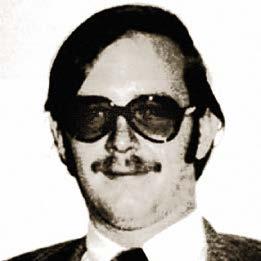
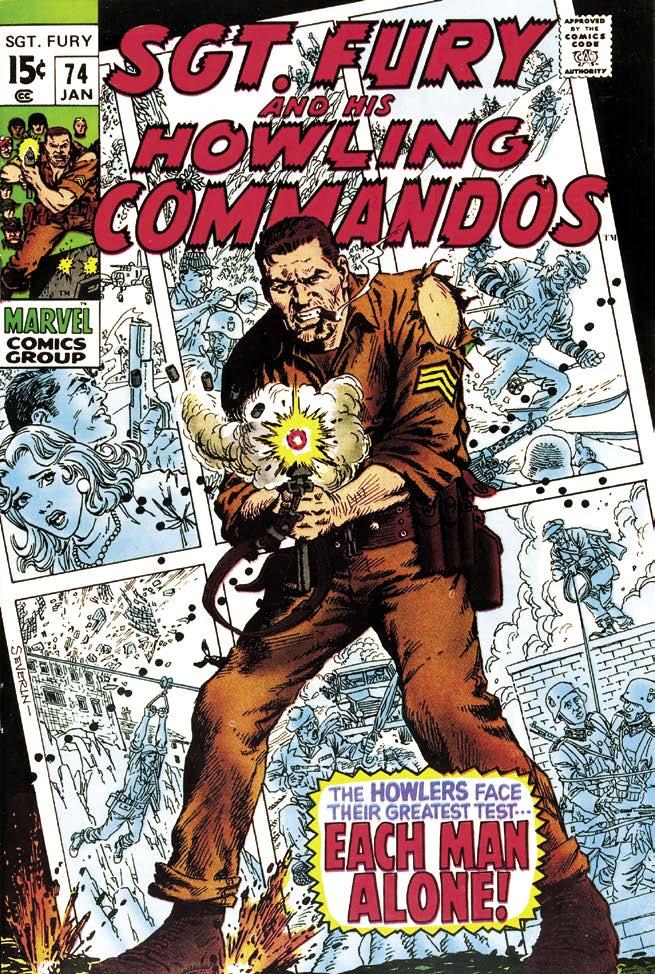
Sgt. Fury and His Howling Comman dos would eventually become the signature series for the creative team of Friedrich, Ayers, and inker John Severin as the Bronze Age rolled around. In an interview with Matthew Price of The Oklahoman published on June 6, 2008, Friedrich talked about how he got Sgt. Fury and remained on the
Howling Bronze Fury
At the dawn of the Bronze Age, one-time EC Comics artist John Severin enlivened Marvel’s Sgt. Fury and His Howling Commandos with his dynamic cover art and finishes to artist Dick Ayers’ interior pencils. Issue #74 (Jan. 1970) featured an unforgettable battle tale by guest writer Archie Goodwin.
TM & © Marvel.
• BACK ISSUE • 3
Spies and P.I.s Issue
gary friedrich
by James Heath Lantz
Eye-Catching Art
(top) Gary Friedrich’s thought-provoking tale “The Deserter,” in Sgt. Fury #75 (Feb. 1970), featured this shocking Severin cover. (bottom) Original art for its title splash, with Ayers pencils. Courtesy of Heritage Comics Auctions (www.ha.com).
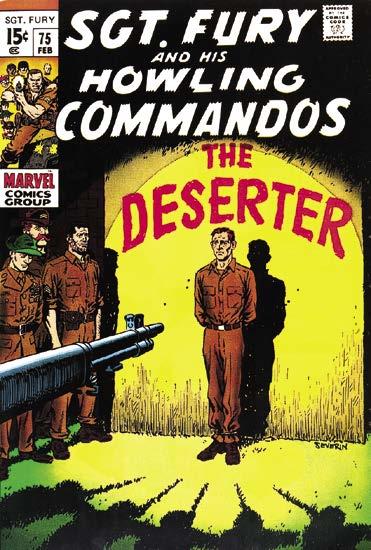
TM & © Marvel.
comic for so long. He said that new writers had to follow an order of assignment types in the Marvel Bullpen. First they had to write romance books, then Westerns, war books, etc., before graduating to superhero titles. By the time Friedrich moved on to superhero books, he wanted to stay on Sgt. Fury even after he was writing higher-profile projects like The Incredible Hulk . Friedrich had grown fond of Nick Fury, Gabe Jones, and the rest of the Howling Commandos. Thus, he said he had talked Stan Lee and Roy Thomas into allowing him to stay on Sgt. Fury. Thomas, however, remembers things differently.
“I don’t recall any such conversation about letting Gary stay on Sgt. Fury,” Thomas tells BACK ISSUE “I don’t even recall Stan or me ever trying to move him off that book, since he was doing it well. But maybe Stan once thought about moving him on from Sgt. Fury just as he had had me turn Fury over to Gary.”
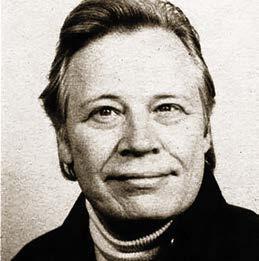
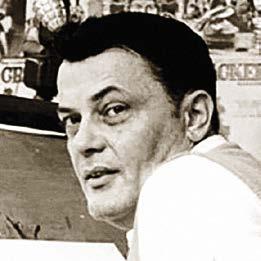
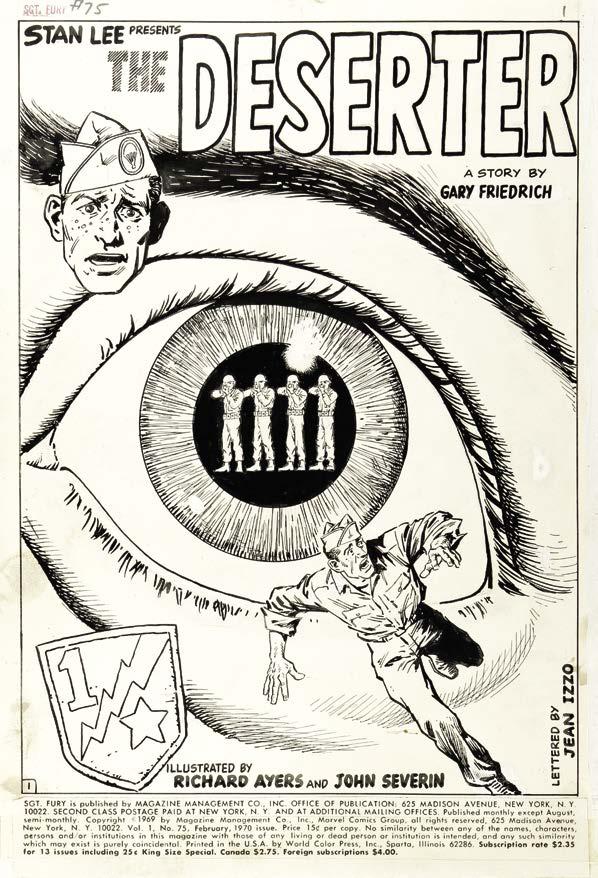
Lou Mougin stated in his Amazing Heroes #22 article titled “The Very Happy War of Sgt. Fury and His Howling Commandos” that Friedrich used his father’s war experiences as inspiration for his run on Sgt. Fury, helping the Friedrich/Ayers/Severin run become morality tales that ask the readers if war is just and necessary. Sure, Nick Fury and his group of ragtag soldiers are fighting Axis totalitarianism, but the cost of that fight can weigh greatly on one’s soul. Friedrich discussed this aspect of his Sgt. Fury work in The Oklahoman, saying that he would use Sgt. Fury to discuss his anti-war stance because he felt as if he was doing some thing to get his message out to people.
In addition to showing readers that war is truly hell, Gary Friedrich, Dick Ayers, and John Severin made each character much more than a two-dimensional hero or villain. The art incredibly shows the internal emotions of everyone involved in the stories that look within the blood and thunder of combat. “Each Man Alone!” from Sgt. Fury #74 (Jan. 1970) is just one example of this. Each Howling Commando has his own mission as a component of Operation Jigsaw. Dino Manelli, an entertainer-turnedsoldier (inspired by Dean Martin), must steal important documents, using his acting skills to woo an officer’s daughter, Frieda, to accomplish this. Ayers and Severin’s use of facial expressions, combined stupendously with guest scribe Archie Goodwin’s writing, convey Dino’s feelings of guilt for using the girl in such a way. The situation gets more com plicated after some heated fisticuffs with Frieda’s father. We later learn that her father is among the German soldiers that realize Hitler is a genocidal madman; he wants Dino to take Frieda out of the country to give her a better life. The creative team once again shows intense feelings with an excellent combination of sequential art and words. The next issue’s brilliant “The Deserter” is a superb example of the Sgt. Fury creative team of Friedrich, Ayers, and Severin telling a story of the human condition within the horrors of war. Private Duane Wilson is the new recruit replacing Eric Koenig. At first, Wilson seems gung-ho to take on the Nazis. Yet, in the heat of battle, he runs away. Fury and the Com mandos recall the events that led to Wilson facing a firing squad. From a visual and narrative standpoint, “The Deserter” delves into the psyches of the characters, particularly Wilson, to tell a compelling story to entertain readers while making them ponder the harsh realities of war. “Tell me, Sarge,” Wilson, with an expression of fearful panic, says to Nick Fury. “Who’s any man to judge another human being?” Those words alone don’t just describe Wilson’s feelings. They also ask the reader if this is what war truly is.
4 • BACK ISSUE • Spies and P.I.s Issue
dick ayers
© Marvel.
John severin
by Patrick A. Reed
PRELUDE: FROM ‘STRANGE TALES’ TO SOLO STARDOM
In the late ’60s, Marvel Comics was in the process of going from upstart publisher to media sensation, building a devoted block of readers on college campuses, garnering a mix of mainstream and underground press attention, licensing their characters for TV and other media, and constantly rewriting the rule book of what comics could and couldn’t do.
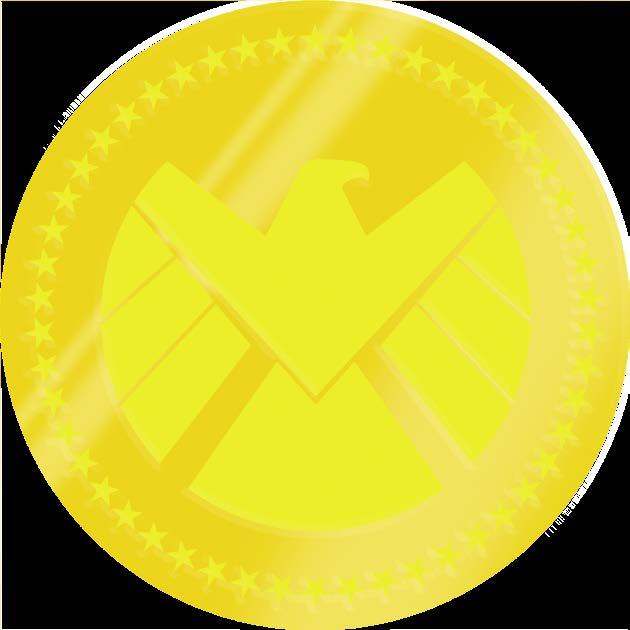
And for a brief time, the most revolutionary and groundbreaking of all Marvel’s publications was some thing of an outlier: a series that operated within the Marvel Universe, but starred a globetrotting secret agent, as opposed to a costumed superhero.
Nick Fury, Agent of S.H.I.E.L.D. started out as the supporting feature in Strange Tales , recasting the roughneck title character of Sgt. Fury and His Howling Commandos as a modern-day super-spy. Secret agents were all the rage in the wake of James Bond’s meteoric rise, and it was only natural for Marvel to look for a way to capitalize on the new craze—they already had a character who could be adapted to fit the bill, all they needed was an organization for him to answer to. And so was born the Supreme Head quarters International Espionage, Law-Enforcement Division—S.H.I.E.L.D., for short.
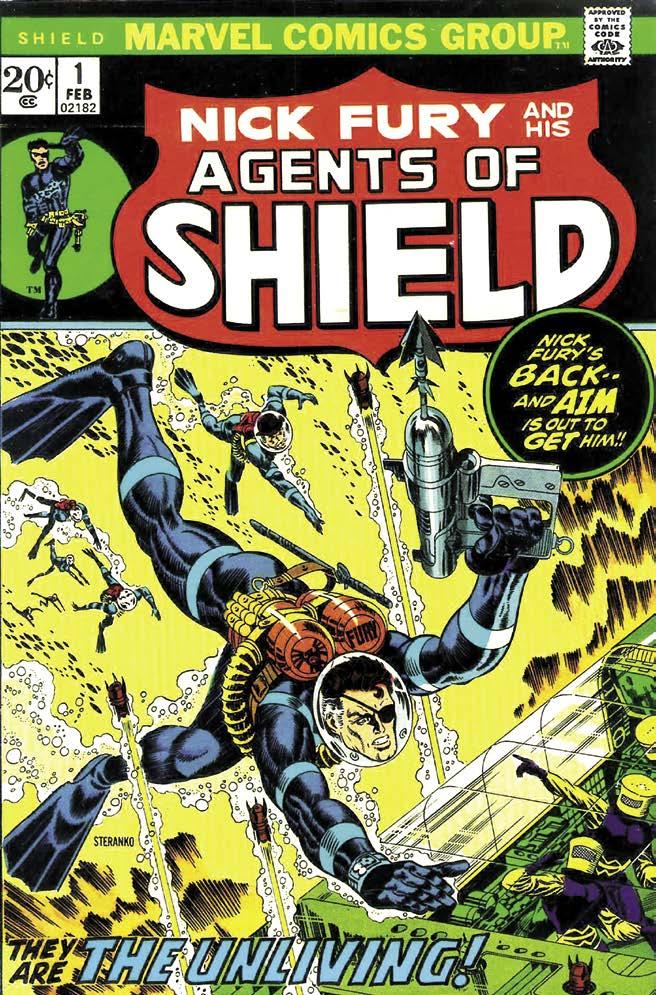
Stan Lee and Jack Kirby produced the series premiere in Strange Tales #135 (Aug. 1965), which told how Fury was recruited to head up this new agency, and introduced a number of foundational elements: an array of Bond-esque gadgets; the helicarrier (S.H.I.E.L.D.’s massive airborne headquarters); and the sinister threat of the international terrorist group Hydra.
But for the first year and a half of its existence, this new strip seemed relatively directionless, hamstrung by a succession of interchangeable device-driven stories, and a rotating cast of writers and artists working along side Lee and Kirby.
Spies Like Us
Note the plural “Agents” in the title of this short-lived Bronze Age reprint series.
Nick Fury and His Agents of S.H.I.E.L.D. #1 (Feb. 1973). Cover by Steranko.
Spies and P.I.s Issue • BACK ISSUE • 11
TM & © Marvel.
The Man from M.A.R.V.E.L.
Marvel’s erstwhile WWII combat star-turnedsuperspy! (left) Strange Tales #135 (Aug. 1965), premiering the “Nick Fury, Agent of S.H.I.E.L.D.” feature and the farreaching terror of the criminal cartel Hydra. Cover by Jack Kirby and Frank Giacoia. (right) Artist Jim Steranko began to shake things up with issue #155 (Apr. 1967), and would soon help the feature spin off into its own title.
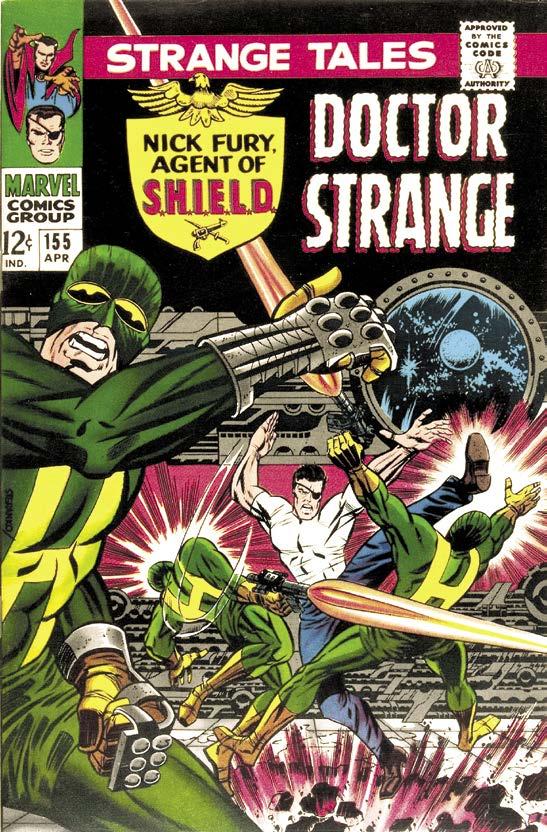
Then Jim Steranko entered the picture. The musician-turned-magician-turned-graphic-designer barely had any comic-book experience when he stepped into the Marvel offices in the summer of 1966, but he quickly picked up a regular assignment: penciling and inking Nick Fury over Kirby’s layout pencils. Just a few months later, in Strange Tales #155 (Apr. 1967), he took full creative control—singlehandedly writing/ illustrating/coloring each issue’s S.H.I.E.L.D. story, reinventing the floundering feature with extended story arcs, innovative visuals, and an inimitable sense of cool. No longer the brawling tough guy of Lee and Kirby’s initial conception, Fury was now a stylish man of action, decked out in high-tech jumpsuits, embarking on increasingly bizarre and ambitious adventures. Steranko expanded the vocabulary of comics with each new issue, incorporating pop-art elements and using his knowledge of printing processes to create previously unseen effects. He also introduced many new faces to bolster the series’ supporting cast, which reinforced the sense that S.H.I.E.L.D. had agents scattered throughout the entire Marvel Universe— lurking in the shadows, working behind the scenes, or operating undercover in plain view.
Through this time, S.H.I.E.L.D. became a key thread tying together Marvel’s continuity. Fury and his fellow agents made cameos in numerous other series, helping build the sense that these characters all existed in a common universe, and providing a consistent backdrop to their increasingly spectacular stories.
In 1968, Marvel discontinued its multi-character titles, and Nick Fury, Agent of S.H.I.E.L.D. launched as a standalone series. And Steranko, freed of working within the 12-page-per-issue format, made the most of this opportunity—across four full-length stories, Fury twice battled the mysterious zodiac-themed Scorpio, faced off against a meglomaniacal scientist on a secret island filled with prehistoric creatures, and swung by the moors of Scotland to confront phantoms and Nazi saboteurs.
But this golden era was short-lived. Steranko moved on to other series after the fifth issue (though he contributed covers for #6 and 7 and featured Fury in his subsequent three-issue stint on Captain America ), and the series floundered despite the best efforts of incoming creative teams. Nick Fury, Agent of S.H.I.E.L.D. #15 (Nov. 1969) saw the headline character felled by an assassin’s bullet, effectively ending the series on a dramatic cliffhanger. As the ’70s dawned, without a commanding officer or an ongoing series to call their own, the agents of S.H.I.E.L.D. scattered to the winds and infiltrated Marvel’s entire family of titles.
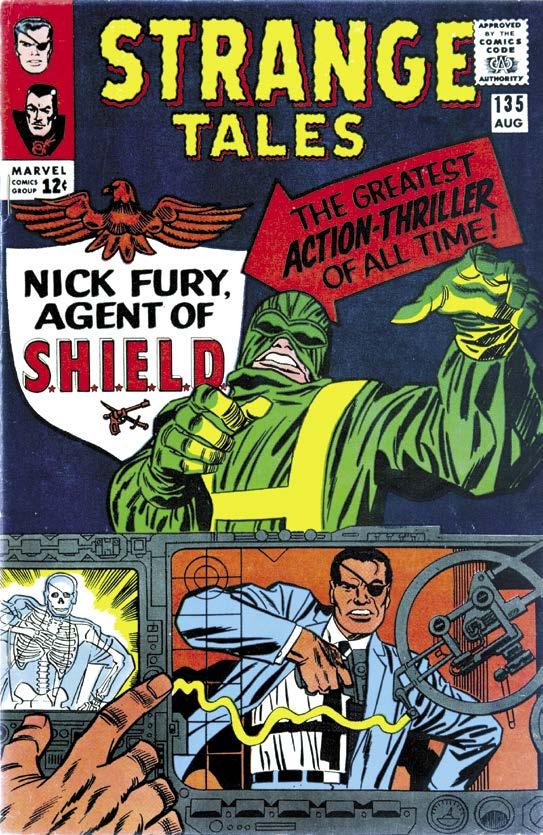
12 • BACK ISSUE • Spies and P.I.s Issue
TM & © Marvel.
Tough-Guy Team-Up
Wordsmith Archie Goodwin and illustrator Howard Chaykin joined forces for the 1989 Marvel graphic novel, Wolverine/Nick Fury: The Scorpio Connection. Shown here are its cover and an interior page showing the stylish digs (and lonely life) of Marvel’s number one super-spy.
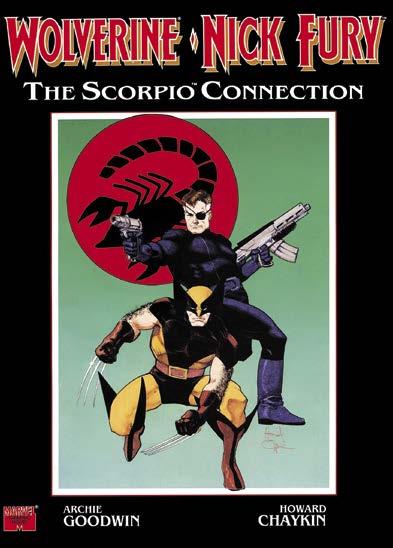
The graphic novel had been in the works for some years before finally seeing release, as Chaykin recalls for BACK ISSUE : “Archie approached me... I penciled it in 1985, and he finished writing it in 1988.” The plot concerned the return of classic Fury nemesis Scorpio, but as the original Scorpio—Nick’s brother Jacob—was long since deceased, it eventually transpires that the costume and powers have been adopted by a different family member: Nick’s illegitimate son Mikel.
howard chaykin
The book’s editor Greg Wright tells BACK ISSUE that, despite the long-gestating nature of the project, it wasn’t difficult to fit into Marvel’s continuity: “Archie and Howard had worked out most everything… that plot was finished before it was handed to me, so that continuity was sealed. People were always playing fast and loose with S.H.I.E.L.D. That was an issue that we tried to get under control, but we figured there were lots of differ ent agents and uniforms and stuff out there, so we didn’t have to worry about it. We did have to make sure Wolverine stayed true to character with the X-Men office, but with Archie Goodwin writing, nobody was going to complain.”

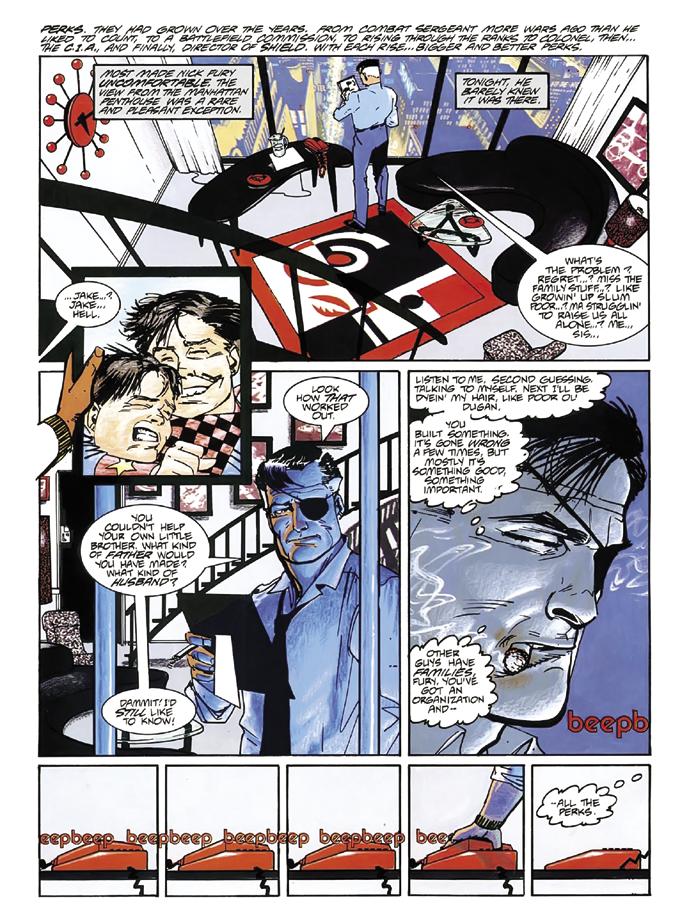
Goodwin spoke on his connection to Nick Fury in Marvel Age #79 (Oct. 1989), while also laughingly acknowledging his culpability for the project’s delays: “I had to write several fill-in issues of S.H.I.E.L.D. when Steranko left [in 1968], and I always felt that I never had the chance to give it my best shot. In the back of my mind, I always wanted another chance… I think that anytime anyone does a graphic novel, a sense of it being very special sets in. For me, it set in spades. Fortunately, it reads as though it was written in three days!”
NOT SHIELDED FROM PROBLEMS
Work began on the new ongoing series in late 1988, and obstacles began to appear almost immediately. First and most obviously, the aforementioned issue that the entire concept of S.H.I.E.L.D. had just been torpedoed. As editor Greg Wright tells BI, “Though S.H.I.E.L.D. was gone, Nick Fury and some of the characters were still around. Mark Gruenwald was now the executive editor at Marvel, and his idea for the ongoing series was along the lines of Mission: Impossible: a covert team utilizing whatever S.H.I.E.L.D. tech Nick Fury had managed to hide from the agency. That was the initial plan, my goal was to have it start that way, and build back up to be more like the original S.H.I.E.L.D.”
Bob Harras remembers that between himself, Wright, and Gruenwald, they established a game plan for the ongoing series: “The goal for this series was to tell a different kind of story—to put together a group that Nick could trust. In the [ vs. S.H.I.E.L.D. ] limited series, he’d learned that so much of what he believed in was false, and he needed to learn to trust people again… because of the challenges at hand, he begrudgingly agreed to go back and work with this small group of people.”
Once the direction of the series was set, however, assembling a consistent creative team proved unexpectedly difficult. Paul Neary was unavailable, having accepted an assignment to ink Alan Davis on new X-Men spinoff series Excalibur . According to Greg Wright, “I needed to find a new artist fast. Luckily, I had been looking for something to do with Bob Hall. Bob had done a great job with the Emperor Doom graphic novel, West Coast Avengers, Squadron Supreme, and Solo Avengers . A phone call later, I had a new penciler!
“But when accepting the gig, Bob told me that the only way he could take on monthly series is if he had the plots
18 • BACK ISSUE • Spies and P.I.s Issue
TM & © Marvel.
HowardChaykinArt.com.
by Ben Herman
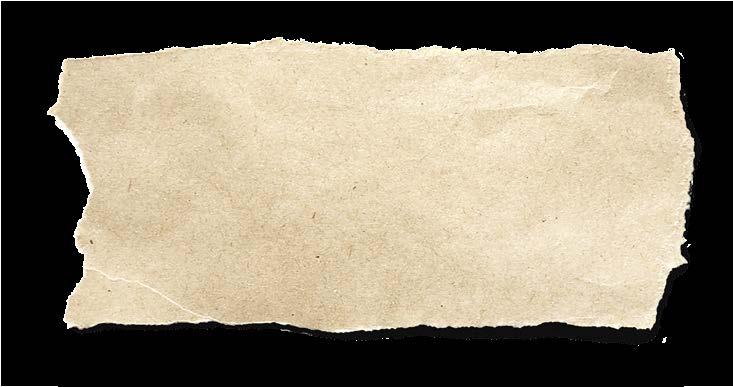
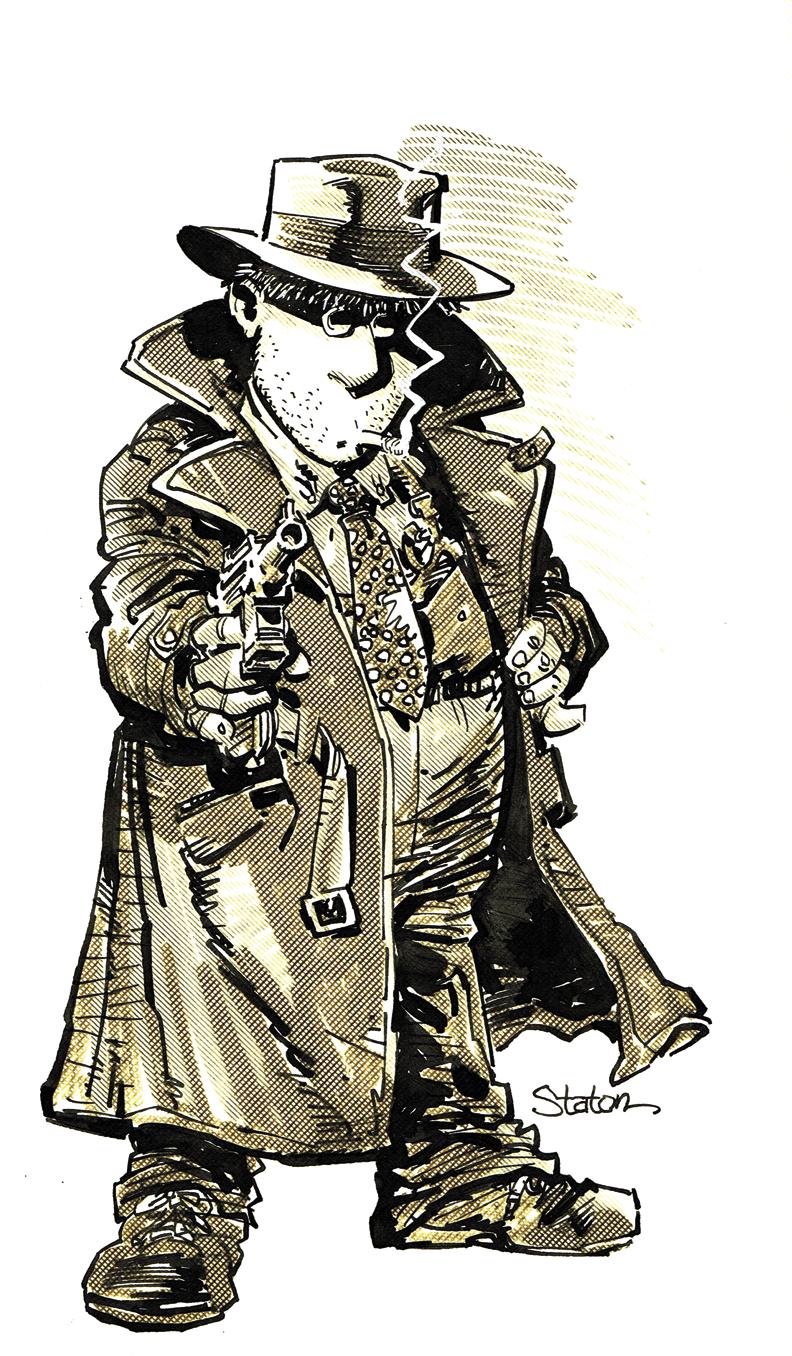
take on superheroes in the pages of E-Man #1 (Oct. 1973).
The entity that would become E-Man began life thousands of years ago when a packet of sentient energy erupted from the star Arcturus. For millennia, this energy wandered the universe, searching for other intelligent life. Eventually arriving on Earth, the energy got caught up in electrical power lines, which led it to the dressing room of burlesque perform er Nova Kane. Taking on human form, the energy-being adopted the identity of E-Man, and Nova gave him the civilian alias Alec Tronn. With Nova as his guide, E-Man protected Earth from a variety of bizarre foes. Although Alec was the ostensible lead of his own book, right from the start E-Man was an ensemble series, with Nova an equal co-star. And with issue #3 (June 1974), another character joined the book’s cast: disheveled, abrasive private detective Mike Mauser.
Its story “The Energy Crisis” is set in New York City during the oil crisis of late 1973. Nova and fellow exotic dancer Rosie Rhedd are walking home from work when Rosie is suddenly pulled through a solid brick wall by an unseen assailant! The shocked Nova goes to E-Man for aid, but he is busy helping with the numerous emergencies caused by the power shortages. Spying a flyer that advertises private detective Mike Mauser’s services, Nova reluctantly heads to his office. Although startled by Mauser’s slovenly appearance, she tells him about Rosie’s strange vanishing. Mauser agrees it’s a fantastic story, but adds, “So long as you’re paying me, I’ll believe anything.”
Mauser and Nova return to the scene of the crime and discover that the wall into which Rosie was pulled belongs to an old warehouse. Mauser spots fresh tire tracks, as well as a crate labeled “Boarsville,” the home billionaire energy magnate Samuel Boar. They drive to Boarsville in Mauser’s VW Bug, but are ambushed on the outskirts of town. Both are captured, but not before Nova makes a phone call alerting E-Man. Alec zips to Boarsville and learns that Samuel Boar is using an unorthodox source of energy to power his empire: living people! Rosie, Nova, and Mauser are just three of the hundreds of innocents kidnapped and plugged into Boar’s generators. Fortunately, E-Man defeats Boar, and the authorities release all of Boar’s victims. Later, back at Mauser’s office, the P.I. offers E-Man a job, to which Nova responds, “Not a chance! He’s a big lovable guy and I want him to stay that way… not become corrupted by a cynical creep like you!” As she storms out, Mauser tells Alec, “That’s a tough little broad you’ve got there.”
Spies and P.I.s Issue • BACK ISSUE • 31
Mike Mauser created by Nick Cuti and Joe Staton. Art © Joe Staton.
My name is Mauser. That’s also the name of my pistol. In my profession, my pistol’s the only reliable friend I have. I take care of it, and it takes care of me. I’m a private eye, and this is my story...
CHARACTER INSPIRATIONS
Interviewed by Jon B. Cooke for Comic Book Creator #9 (Summer 2015), Joe Staton detailed how Mauser came about:
“Nick had the idea for a detective based on [actor] Arnold Stang. He was a little guy with a really nasal voice, little glasses… And since Nick was hanging out with Wally Wood and they had guns all over the place, the idea of Mauser… Nick had a Mauser. Very cool gun. The ultimate gun, visually, and it came together.”
When Mauser was created in the early ’70s, Staton was challenged by a lack of artistic reference. “The visual I wound up with Mauser—this was obviously before the Internet, and it was hard to find a lot of things, so I didn’t really have any reference for Arnold Stang. I knew who he was, just generally, but that was when the Dustin Hoffman/Steve McQueen movie was out, Papillon. And there were all these pictures of Dustin Hoffman in these really thick glasses in Papillon, so I just thought, ‘Well, he’s not Arnold Stang, but he’s close enough.’”
Nick Cuti sadly passed away in February 2020; however, he and Staton were interviewed about E-Man by Michael Ambrose in BACK ISSUE #13 (Dec. 2005), and he shared his thoughts on Mauser’s origins:
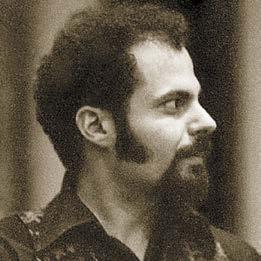
“Mike Mauser just was supposed to be a one-time character, he was just going to be in this particular story [ E-Man #3 —ed. ]. I’ve always liked private-eye stories, and this gave me an opportunity to create a private-eye character. I decided to insert him in here, and I was just going to use him for this one story and then I was never going to use him again.”
Mauser, however, did return less than a year later, in the pages of E-Man #7 (Mar. 1975). The mysterious “TV Man” has been using alien technology to cause E-Man to lose control of his powers. Seeking a final showdown, TV Man ambushes Mauser in his office, instructing him at gunpoint to deliver an ultimatum to E-Man. The unperturbed Mauser, staring down the barrel of TV Man’s gun, deadpans, “You know how to make a point. Do you still need me… or is a truck about to come through that tunnel?”
Passing along TV Man’s message, the next day Mauser brings E-Man over to Rockefeller Plaza for a “high noon” showdown with the villain. Having served as messenger, the P.I. announces, “It’s getting close to noon so I’m going to take off. There’s no hero in my blood.”
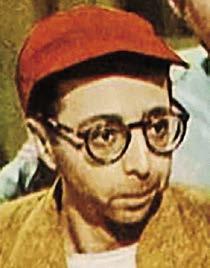
Despite his protestations, it would later become apparent that Mauser possesses more than his share of bravery and heroism. He was akin to Rick Blaine from Casablanca, who always insisted “I stick my neck out for nobody,” but who, when push came to shove, was hardpressed to turn his back on someone in need of help.
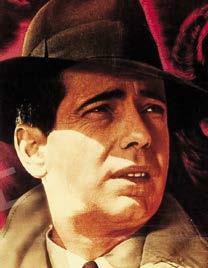
Staton shares his thoughts about Mauser’s relatively quick return. “My impression is that Nick always had plans for Mauser, following his debut. He showed up as such a solid character on his own, right off the bat, that it was clear that Nick had been thinking about him for some time.” It would seem that after Mauser’s original “one-time” appearance in E-Man #3, the character made an impression upon Cuti.
The following issue, E-Man #8 (May 1975), established Mauser as a regular presence in the series. Nova catches E-Man playing cards with the private eye. Concerned about the impact Mauser might have on the impressionable energy being, Nova snaps at the detective, “He doesn’t know any better, but you should
be arrested for trying to corrupt a minor!”
Despite Nova’s dislike for Mauser, in issue #9 (July 1975) Alec is officially working with the private eye to investigate the mysterious criminal Genius One. Alec, being made of energy, has the advantage of being able to change his shape, but the all-too-human Mauser’s “disguise” is hiding inside a garbage can, which he blends into very easily!
CALLING FOR BACKUP!
That same month, Mauser found a second home, as a backup feature in the Charlton adventure series Vengeance Squad. Stories featuring Mauser appeared in all six issues of Vengeance Squad, cover-dated July 1975 to May 1976. As Cuti explained in BACK ISSUE #13, “I eventually started loving the character so much that I felt he was wrong for superhero comics because he was a private eye, and I don’t really like to mix genres. So when [writer] Joe Gill came up with Vengeance Squad, I asked [editor] George [Wildman] if I could do Mike Mauser as a backup and do these little private-eye stories without any superhero attached to it at all.” In some of these backup tales, Mauser is hip-deep in the action, mixing it up with all sorts of dangerous criminals; in others, he is an observer, delivering commentary on the activities of various unsavory characters.
E-Man was cancelled with issue #10 (Sept. 1975). Mauser would subsequently appear in the E-Man story by Cuti and Staton that ran in issue #4 (Mar.–Apr. 1976) of the semi-professional fanzine Charlton Bullseye. “…And Why the Sea Is Boiling Hot” has Alec and Nova working with Mauser, investigating the disappearances of several ships and aircraft. This turns out to be the work of space pirates. Receiving a signal from Alec and Nova,
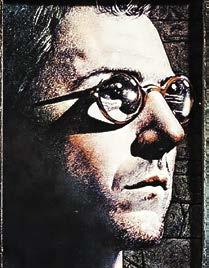
Alec Tronn, Private Eye?
(top) Nova nixes Mauser’s offer in E-Man #3. Original art courtesy of Ben Herman. (bottom) Visual and person ality inspirations for Mauser: Arnold Stang (from The Man with the Golden Arm), Dustin Hoffman (from Papillon), and Humphrey Bogart (from Casablanca). Excerpted from movie lobby card and posters, courtesy of Heritage.
Art © Joe Staton. The Man with the Golden Arm © United Artists. Papillon © Allied Artists. Casablanca © Warner Bros.
Spies and P.I.s Issue • BACK ISSUE • 33
nick cuti
by Dewey Cassell
No issue on spies and P.I.s would be complete without Encyclopedia Brown, Boy Detective. If you attended elementary school in the mid- to late 1960s (or several decades after), you probably remember the ten-yearold who only charged 25 cents to solve a crime. What you may not know is that for almost two years, Encyclopedia also had his own newspaper comic strip.
Donald J. Sobol—the J was just an initial—created the character Leroy “Encyclopedia” Brown in 1961 and wrote the first book in just two weeks, but received two dozen rejections before it was published by Bantam Skylark in 1963. That was the beginning of a mystery series about the perpetual fifth grader that lasted 50 years. Each book usually contains ten separate stories and readers are encouraged to try to solve the mysteries. Solutions are provided in the back of the book, a format inspired by a puzzle book Sobol saw at the New York Public Library.
In the stories, Encyclopedia helps his father, the police chief in the fictional seaside town of Idaville, solve crimes at the dinner table. He also has his own detective agency, which he runs out of the family garage, to help kids in the neighborhood solve cases for “25 cents per day, plus expenses—no case too small.” Cases range from pranks to not-so-petty theft. He is aided by his close friend and partner, Sally Kimball, who also acts as bodyguard for Encyclopedia when he gets picked on by local bully Bugs Meany
and the Tigers gang. Sobol referred to Encyclopedia as “America’s Sherlock Holmes in sneakers.”
The Encyclopedia Brown series of books proved to be very popular, aided by the fact kids could order the books at school through Scholastic catalogs. So, it is not surprising that the idea would be adapted to other formats.
Beginning December 3, 1978, Encyclopedia Brown appeared as a newspaper strip, syndicated by Universal Press Syndicate, which also carried Doonesbury, Ziggy, Cathy, and For Better or For Worse. The Encyclopedia Brown strip ran both black-and-white dailies and color Sundays, following a format similar to the books. The daily strip featured ongoing mystery stories that ran for one to three weeks, typically the latter. The Sunday strip was completely separate from the daily storyline, featuring “done-in-one” mysteries with the solution printed upside down in the last panel. Both allowed for new readers to easily pick up on the series. The approach of having separate storylines was not unusual, given that newspapers might carry either the daily strip or the Sunday, but not necessarily both. The Sunday strips followed the traditional formats, appearing in half-, third-, and quarter-page formats as well as the tabloid format, with some panels omitted depending on the format.
The comic strip was credited to Sobol and artist Frank Bolle, but it was actually written by Elliot Caplin, younger brother of Al Capp, creator of the long-
Eagle-Eyed Kid
Boy detective
Encyclopedia Brown solves an ecological mystery in a Sunday installment of his short-lived comic strip. Scans illustrating this article are courtesy of Dewey Cassell.
Encyclopedia Brown © Penguin Random House.
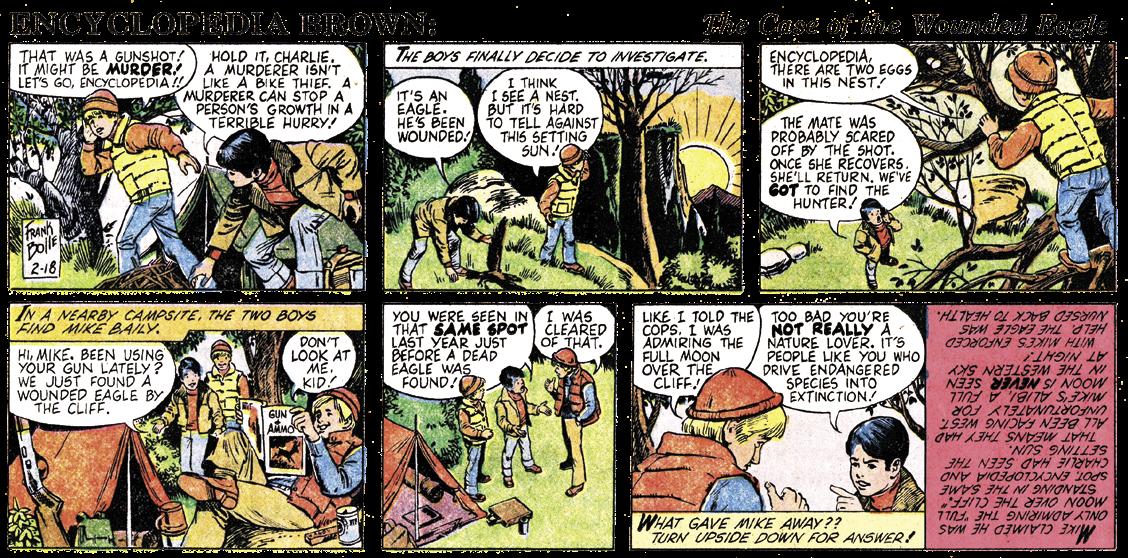
Spies and P.I.s Issue • BACK ISSUE • 37
Strong female leads: Honey West, Modesty Blaise, April Dancer… they’ve got nothing on Michael Tree. Ms. Tree to her fans.
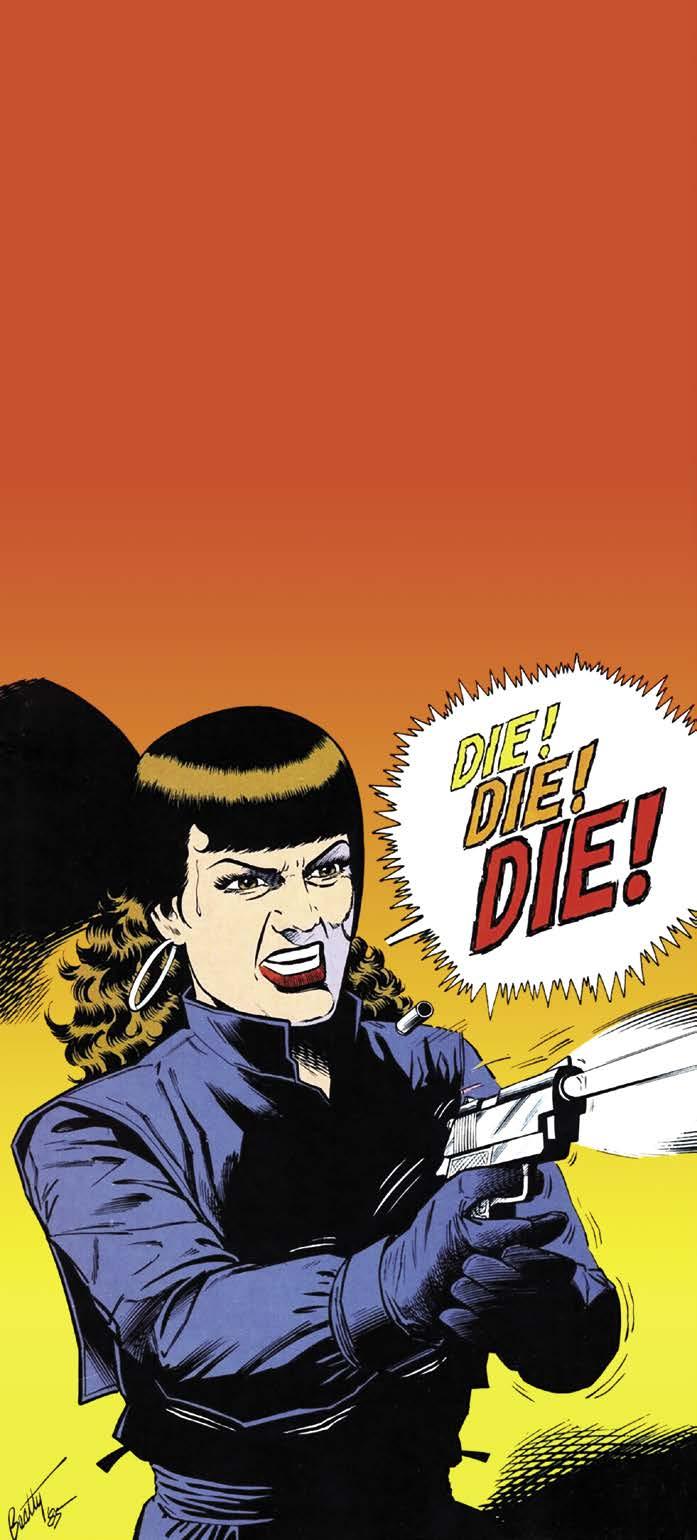
What if... Mike Hammer finally married his secretary, Velda, herself a tough P.I., and on their honeymoon he was murdered!? That’s how Max Allan Collins explains the thoughts behind the creation of Ms. Tree, co-created by artist Terry Beatty.
Michael Tree becomes the widowed owner of her husband’s firm, Tree Investigations, Inc. Her staff of Effie, her secretary and business manager, and two operatives, Roger Fremont, a former district attorney, and beginner Dan Green, would assist her to tackle the tough cases. The Muerta Crime Family, responsible for her husband’s death, was top on her list. She also tackled cases that could have been pulled from today’s headlines—that explored themes that Max couldn’t explore in the family-friendly Dick Tracy strip—homicidal lesbians, serial killers, crooked cops, child molesters, pro-life killers, and more.
And Ms. Tree pushes on… usually violently… which results in her arrest, a subsequent imprisonment, a stay in a mental hospital, and of being medicated against her will.
She deals with an unwanted pregnancy, as well as her late husband’s stepson, who is in love with a Muerta Family girl, which results in the unexpected involvement of the Muerta Family in her and her family’s wellbeing.

Max Allan Collins (b. March 3, 1948) is probably best known as a mystery writer. But that just scratches the surface of his impressive catalog of accomplishments. A frequent Mystery Writers of America “Edgar” nominee in both fiction and non-fiction categories, he has earned an unprecedented 18 Private Eye Writers of America “Shamus” nominations, winning for his Nathan Heller novels, True Detective (1983) and Stolen Away (1991), receiving the PWA life achievement award, the “Eye,” in 2007. Max has been prolific producing mystery novels, screenplays, movie novelizations, graphic novels, comic books, comic strips, trading cards, short stories, historical fiction, and non-fiction historical compilations, His novels, Road to Perdition , Road to Purgatory , and Road to Paradise were the basis for his trio of graphic novels known together as On the Road to Perdition, which in turn was the basis of the 2002 film Road to Perdition, which starred Tom Hanks, Paul Newman (in his last live-action theatrical film acting role), Jude Law, and Daniel Craig.
Max scripted the comic book Batman in 1986–1987 and several maxiseries. He also created a new origin for Jason (Robin) Todd. That same year, Max and Terry created the character Wild Dog for DC and not only was it a miniseries, and a feature in Action Comics Weekly [see BI #98 and 102 ed ], it went on to be a prominent character in the CW TV show Arrow, based on DC’s Green Arrow.
Max took over the writing of the Dick Tracy newspaper strip in 1977. Tracy creator Chester Gould had retired that same year and his last strip was printed on December 25, 1977. Max
One Tough Broad
Her
Cover detail from Ms. Tree #21 (Sept. 1985) by Terry Beatty.
Ms. Tree TM & © Max Allan Collins and Terry Beatty.
intentions are quite clear here, don’t you think?
40 • BACK ISSUE • Spies and P.I.s Issue
max allan collins
by Stephan Friedt
would debut the next day. He would continue to write the strip (with art by Gould’s former art assistants) until 1992, when the syndicate reorganized their comic-strip holdings and replaced Max with a staff writer at half the cost.
Max was a long-time fan of mystery writer Mickey Spillane. That would develop into a friendship, and the two collaborated on a comic-book series in the 1990s called Mike Danger . When Spillane died in 2006, Max was entrusted to finish several uncompleted works by Spillane including Dead Street, The Goliath Bone, and The Big Bang
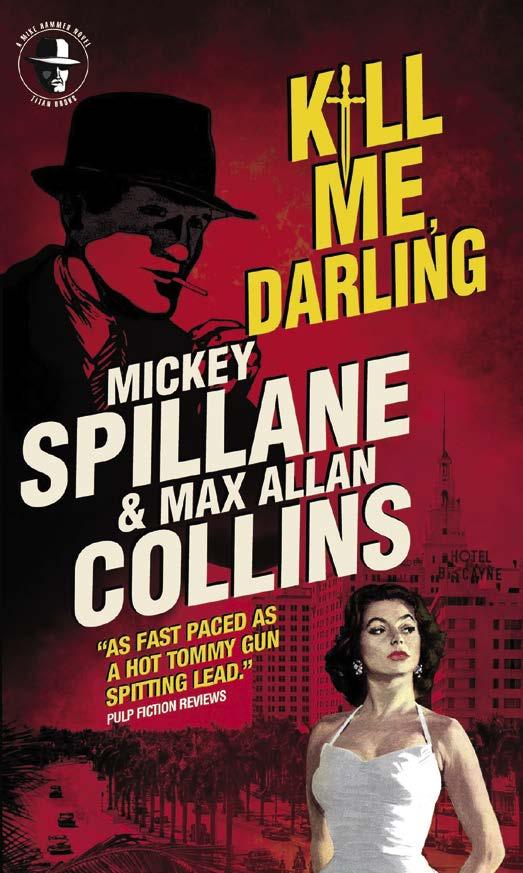
With Lee Goldberg, he co-founded the International Association of Media Tie-in Writers, an association developed to assist writers of TV and movie tie-in noveliza tions and expansion novels. Max has written expansion novels for the TV series Dark Angel , CSI (books and comics), and Bones.
As an independent filmmaker in the Midwest, he has written and directed five features and two documentaries, including the Lifetime movie Mommy (1996) and a 1997 sequel, Mommy’s Day ; and has written and performed music with his rock band, Crusin’.
Terry Beatty (b. January 11, 1958) has worked as a penciler and inker in the comic industry for decades. I first saw his work in The Buyer’s Guide for Comic Fandom in the 1980s, after I was affiliated with that comic fandom staple (1975–1976). He wrote columns,
comic strips, and did dozens of covers in the 1980s. He co-created Ms. Tree in 1981 and has been with that character in all its incarnations.
In the late 1980s, Terry worked on a variety of things for DC, including Wild Dog. The 1990s saw Ms. Tree at DC. In the 2000s, Terry started a decade-long run as the primary inker for DC’s animated TV tie-in comic series, including a four-year-straight run inking Batman Strikes.
In the early 2000s, Terry spent time as a “Visiting Artist” at the Minneapolis College of Art and Design (MDAD), participating in public lectures and discussions, and providing additional educational programming for students.
From 2012–2017, Terry took over as the artist for the Sunday episodes of the King Features comic strip, The Phantom. In 2013, he added the art chores for the King Features comic strip, Rex Morgan, M.D. And in 2016, Terry was handed the full reins for Rex Morgan, M.D., being responsible for the writing and art duties on the strip seven days a week, where you can still find him to this day.
Terry regularly provides cover paintings for Scary Monsters magazine, as well as its spinoff Monster Memories Annual. He is also an accomplished sculptor and does fantastic jobs on plastic and resin model kits.
I talked to Max and Terry about the beginnings of their love for comics and those early days of Ms. Tree…
– Stephan Friedt
(right)
Buyer’s
Fandom #402
31,
Dr. Strange TM & © Marvel.
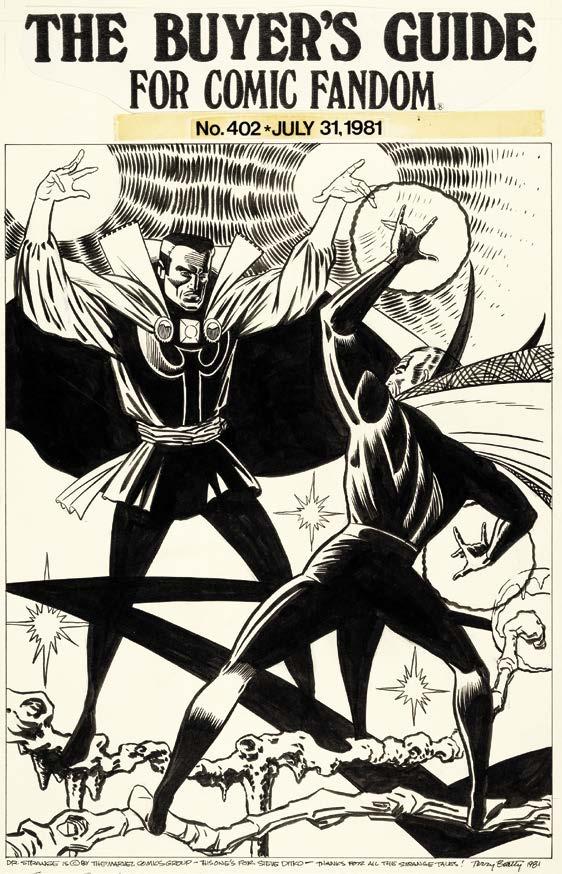
He’s Got Some Spillane-ing to Do
(left) Max Allan Collins has kept the spirit of crime novelist—and mentor and friend— Mickey Spillane alive in several novels.
Original Terry Beatty art to The
Guide for Comic
(July
1981), featuring Doctor Strange. Courtesy of Heritage Comic Auctions (www.ha.com).
Spies and P.I.s Issue • BACK ISSUE • 41
FRIEDT: How did the Word Warriors benefit comic come about?
BEATTY: That had to do with the literacy benefit group that ran the art auction at the old Chicago Cons, I think. George Hagenauer was behind that… maybe. Ancient history—so my memory’s shaky on some of this.
COLLINS: Yes, that was George Hagenauer, the chief research assistant on my Nate Heller historical mysteries.
In 1988, a paperback edition of Ms. Tree stories showed up on the bookstore racks… Ms. Tree: The first totally illustrated murder mystery . It reprinted the story arc “The Runway.”
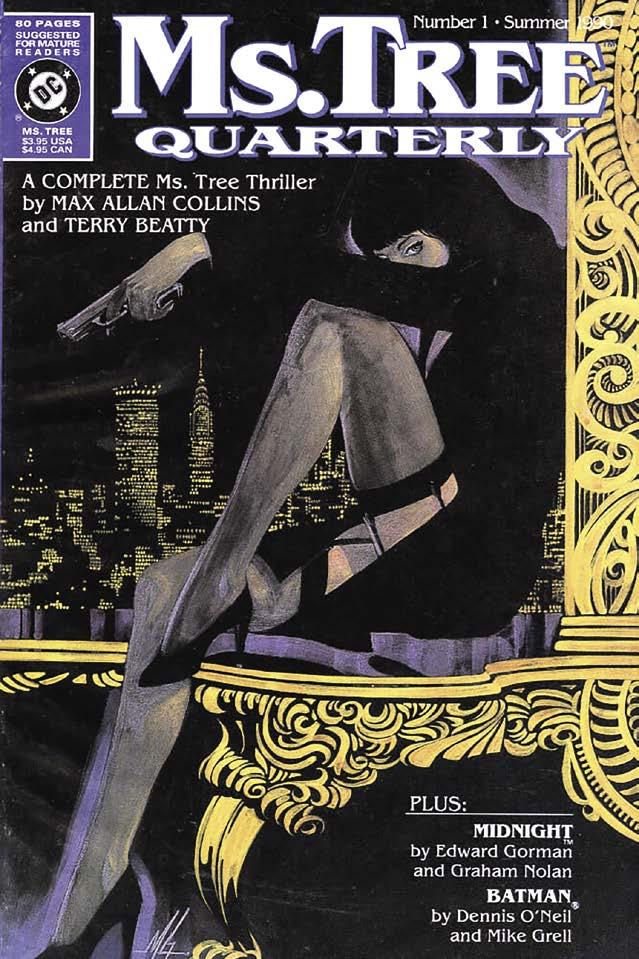
FRIEDT: What’s the story behind the solo paperback from Paperjacks, back in 1988?
BEATTY: Can’t really recall. There was supposed to be a second one. I painted the cover, which I turned in and have never seen again.
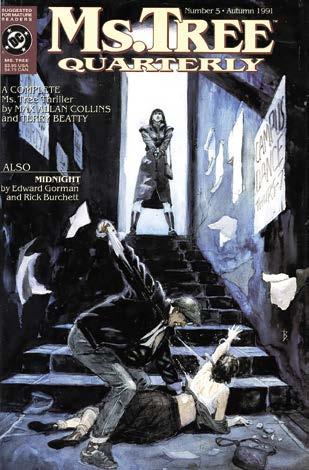
COLLINS: The married couple behind the Bogie’s Restaurant in NYC briefly had a line of paperback mystery novels and asked us to form a graphic novel out of one of our continuities. It would have gone on for more had the line not abruptly… well, failed.
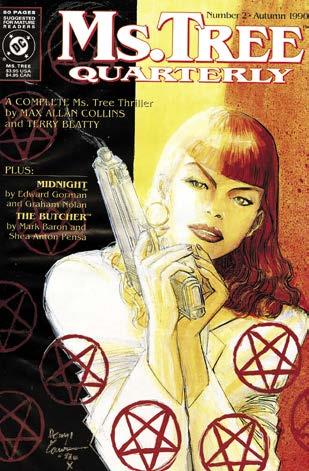
In the summer of 1990, Ms. Tree became a DC comic book. The first eight issues were titled Ms. Tree Quarterly . Issues #9 (1992) and 10 (1993) were titled Ms. Tree Special . Max provided the scripts and Terry provided the interior art, with covers and interior pinups illustrated by such talents as Mike Grell, Denys Cowan, Graham Nolan, and brothers Scott and Bo Hampton, among others.
FRIEDT: The DC years: How did that come about?
BEATTY: Mike Gold (our editor) was a friend and wanted to bring the feature to DC.
COLLINS: Mike Gold was the champion of the Collins/ Beatty team. We did Wild Dog for him, too.
FRIEDT: What was it like working with DC?
BEATTY: Slick production and consistent paychecks. All good.
COLLINS: Again, the artistic freedom of the indies followed us into the big-time. Mike Gold should get all the credit for that.
FRIEDT: You had some fantastic fellow comic-book people provide pinups and covers. Any stories to go with some of the contributions?
BEATTY: No stories to speak of, but it sure was a treat to have their work in our comic. I inked the Jack Kirby Captain Victory drawing in #50—that was a treat. Joe Rubinstein’s oil portrait of Ms. Tree [back cover of #50] still hangs on my studio wall.
COLLINS: It was a thrill to be endorsed by the like of Will Eisner. Terry made that happen.
Detective Comics
DC Comics temporarily published the gal gum shoe’s adventures in the early 1990s in the title Ms. Tree Quarterly, featuring covers by guest artists. Here are three examples: #1 (Summer 1990) by Mike Grell, 2 (Autumn 1990) by Denys Cowan, and 5 (Winter 1991) by Bo Hampton.
Ms. Tree TM & © Max Allan Collins and Terry Beatty.
Issue • BACK ISSUE • 47
Spies and P.I.s
Your “takeaway” from this article should be that Mark Evanier (that’s me) had a very wonderful experience working with some fine artists (that’s Will Meugniot, Dan Spiegle, and a few others) on a couple of comic books for a small publisher (that’s Eclipse) between 1983 and 1988. If I had space here, I’d talk more about the “few others” who included Rick Hoberg, Erik Larsen, Chuck Patton, Will Blyberg, Al Gordon, Steve Rude, Mike Sekowsky, Richard Howell, Jerry Ordway, Brent Anderson, Dave Stevens, Mike Royer, Mitch Schauer, and a few other “others.”
And it may take the rest of those 2,000 words to adequately tell you about working with Mr. Spiegle on Crossfire, which is what I’ve been asked to write about. I don’t have an absolute favorite of all the comics I’ve worked on, but if you forced me to pick the Top Three, that would certainly be among them.
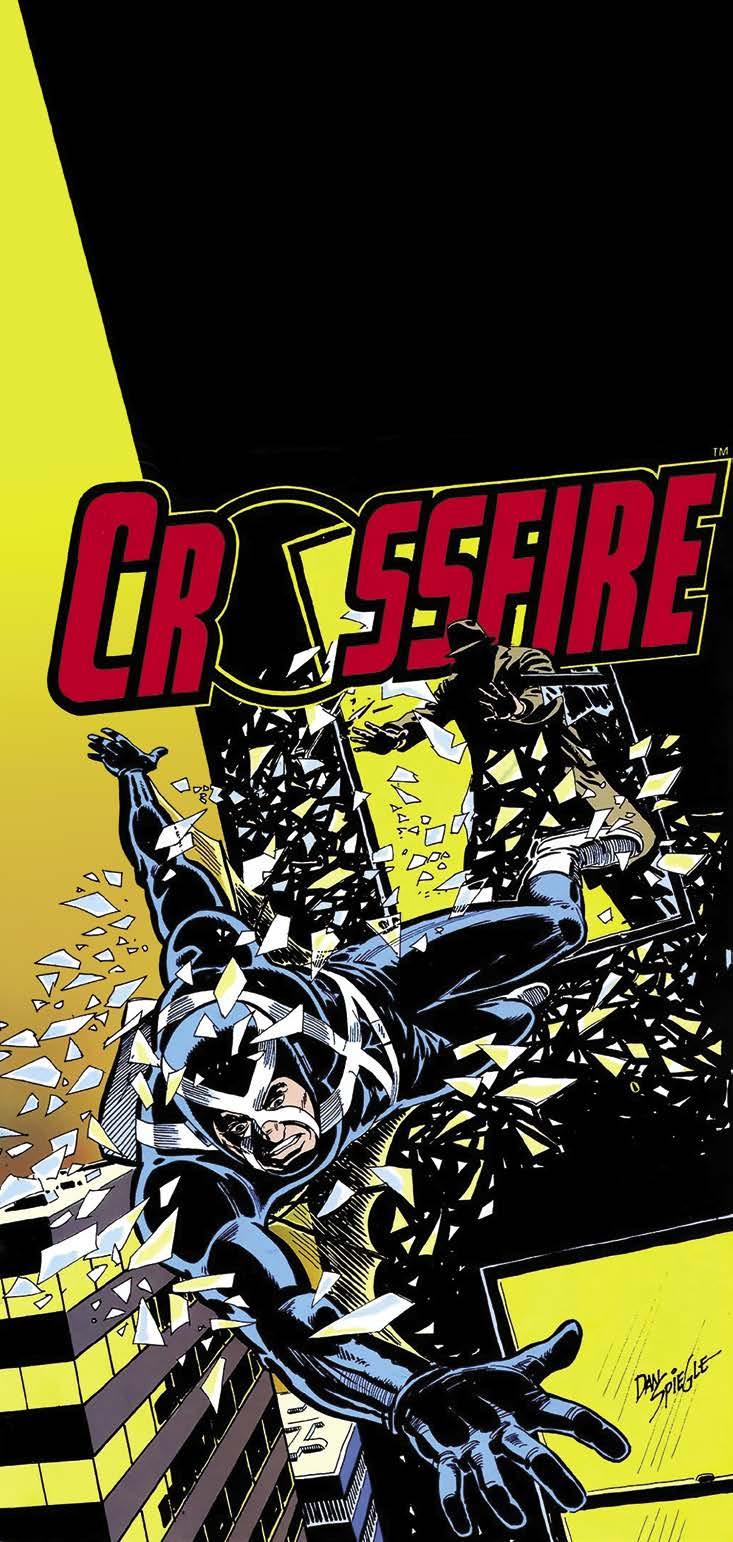
Crossfire was, as you may know, a spinoff from The DNAgents , a comic I co-created with my friend Will Meugniot. Several places on the Internet, I get listed as sole creator, and that’s just plain wrong. The DNAgents comic was created by Evanier and Meugniot. Crossfire was created by Evanier, Meugniot, and Spiegle. If you come across someone saying otherwise, please help me out here and let them (or me) know.
At the time Will and I came up with our little team, I was also writing Blackhawk for DC Comics, illustrated by Dan. That book might also make my Top Three, largely because of the joy of seeing what Dan did with my scripts. He had long been one of my favorite comic-book artists, dating back to when I was a reader (only) and I expected to remain one. I certainly hadn’t the slightest inkling I would ever work in the field, let alone collaborate with the guy who drew Maverick and Korak and Space Family Robinson and all those Disney comics and so many others for Western Publishing’s Dell Comics line and (later) Gold Key.
Dan and I were first thrown together on Gold Key’s Scooby-Doo comic, and we just clicked—a happy pairing. I would write a story and Dan would do such a fine job of illustrating it that I’d think, “Wow. I’ve got to work harder to make my scripts worthy of this artwork.” We teamed here and there on many projects, including a line of Korak, Son of Tarzan comics published overseas and the Scooby-Doo comic (again) when it was briefly published by Marvel.
Everyone Falls for Crossfire
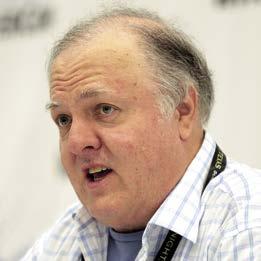 Guest columnist Mark Evanier recalls the fun he had co-producing Eclipse Comics’ Crossfire series in the 1980s. Crossfire #3 (July 1984) cover by Dan Spiegle.
Guest columnist Mark Evanier recalls the fun he had co-producing Eclipse Comics’ Crossfire series in the 1980s. Crossfire #3 (July 1984) cover by Dan Spiegle.
Spies and P.I.s Issue • BACK ISSUE • 51
Crossfire © Mark Evanier, Will Meugniot, and Dan Spiegle.
mark evanier
Photo by Gage Skidmore.
by Mark Evanier
Early Crossfire
(top left) Costumed spy Crossfire, in the form of Jeff Baker, was first seen in DNAgents #4 (July 1983). (top right) The Crossfire mantel is passed from Baker to Jay Endicott in issue #9 (Feb. 1984). (bottom) Crossfire #1 (May 1984).
DNAgents © Mark Evanier and Will Meugniot. Crossfire © Mark Evanier, Will Meugniot, and Dan Spiegle.
I also got to know Dan, his wife Marie, and his daughter Carrie— all lovely people. Carrie often did the lettering on what her father drew, including on Crossfire.
The book more or less came about because Dan and I were not happy with what was happening with Blackhawk at DC. Long story short: It was selling better than DC expected, but the numbers went down as the cover price went up. I was bickering with the firm’s publicity folks about a lack of promotion and support in the marketplace… and we also had the problem that it was a war comic set in the second of our World Wars. At the time, a big source of revenue for DC was a firm in Germany that paid hefty fees for reprint rights, and they were somehow not interested in a comic that was mostly about killing Germans.
Dick Giordano was the guy then in charge at DC, and one day, he called to inform me that they were thinking of cutting the book from monthly to bimonthly. After checking with Dan, I told Dick that if that was the case, Dan and I would rather leave the series. And Dick actually said to me, “I don’t blame you. We haven’t treated you or that comic very well.”
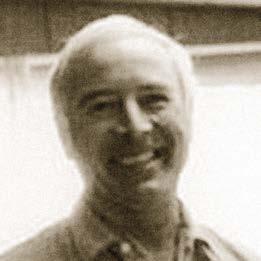
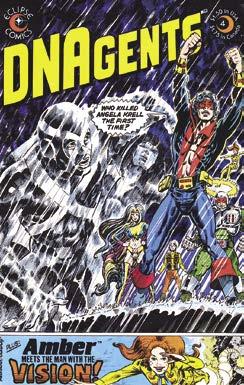
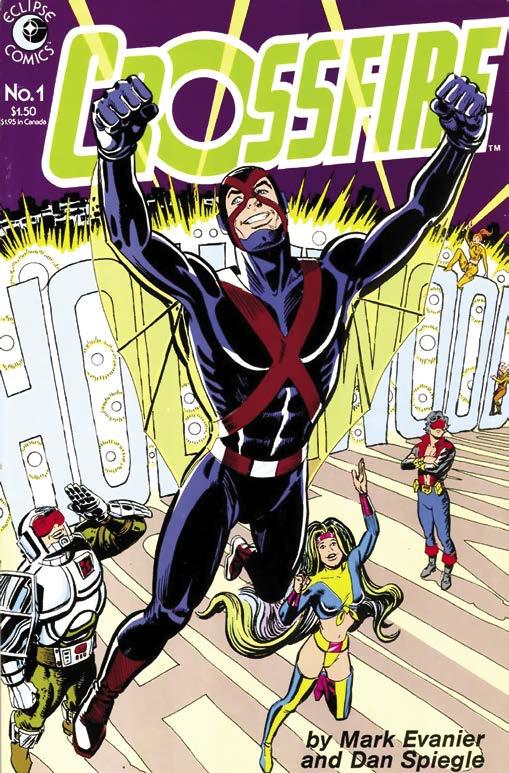
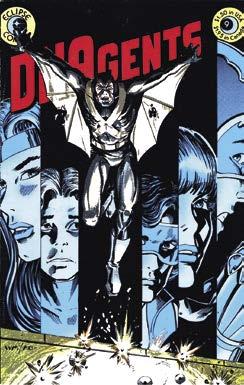
So now I had the time to do another comic each month and I had a wonderful artist I wanted to work with. We also had this character named Crossfire that Will and I had introduced in DNAgents —an industrial spy named Jeff Baker who operated with enough gimmicks to qualify as a costumed supervillain. In one issue, Baker was killed and a good guy named Jay Endicott took over his identity, getting hired by bad guys and subverting their badness from within. Some of the Crossfire sequences had been drawn by Dan Spiegle, not because we were configuring a spinoff, but because Will was being offered a lot of better-paying animation work. Having Dan draw some pages enabled Will to take some of those animation jobs… …though maybe—I dunno—we were subconsciously thinking about a separate Crossfire comic book which Dan and I could do together. I just remember that after we quit Blackhawk , I was trying to think what that new Evanier/Spiegle project might be, and I suddenly realized we had one all set and ready to go. I called Will and he said, “Sure.” Then I called Dean Mullaney, the publisher at Eclipse, and told him what we wanted to do. Immediately after hanging up that call, I began writing the first issue.
Before I try to explain the sheer joy of working on this book with Dan, let me tell you the one negative in working with Dan: He was ridiculously reliable.
Ask anyone who has ever been in the position of editing comic books and they will overwhelm you with horror stories of freelancers being late with work; of trying to phone the guy to ask, “Where is it?” and he either doesn’t answer his phone or does and insists “It’s almost done” when he hasn’t even started on it. Dan never did that in his entire career—not to me, not to anyone.
And any editor will also tell you of work that did come in and was replete with mistakes and poor drawing and panels that had to be redone. Dan never did that to anyone either.
You may wonder how reliability could be a problem. Well, it some times is if you’re the one who has to keep feeding the reliable guy scripts.
When an artist has nothing to draw, he isn’t earning money—a rotten thing to do to your partner. Every so often, Dan would need something to draw tomorrow, and I’d have to shove everything else in my life to one side and work on that next script.
Dan lived in Carpinteria, California—a lovely seaside city in south eastern Santa Barbara County. I lived, as I do now, in Los Angeles, about 82 miles southeast of Carpinteria. At the time, we didn’t have email or fax machines. We did have Federal Express, but it didn’t then offer overnight service to Santa Barbara… and even if it had, the cut-off time to send something was 6:00 PM, and I’m at my most prolific after dark.
So I’d work until 1:15 AM, when I would stop writing and start printing. As you surely know, when you’re in a hurry, your printer senses that and it jams, just to enjoy the sight of you in a mad panic. Finally, I’d get the pages printed, jam them into an Express Mail envelope, leap into my car, and head for the 24-Hour Post Office near Los Angeles International Airport.
52 • BACK ISSUE •
P.I.s Issue
Spies and
dan spiegle
Marvel Comics arguably has the best villains in comics, from Galactus to Dr. Octopus. While Dr. Doom is primarily a Fantastic Four foe, he sporadically battles other heroes like the X-Men. The same goes for X-Men adversary Magneto, who has fought the Avengers on occasion. However, there is one villainous organization that has faced off against most of the Marvel Universe at one time or another and continues to terrorize them to this day: Hydra.
The name “Hydra” sends a chill down the spines of the heroes of the Marvel Universe, from S.H.I.E.L.D. to Spider-Woman and even to Team America. This mostly faceless criminal operation may
by Ed Lute and Joe Norton
not have many colorful villains who stand out and are recognized without their hooded attire, but that’s part of what makes them so terrifying. You don’t know who the members are underneath their green garb, or just how many people make up their ranks. Anyone could be a member. They could turn up any where. And they never quit. They just keep coming and coming and coming.
So, if you can’t beat ’em, join ’em. BACK ISSUE proclaims, “Hail Hydra!” as we review the origins of the organization during the Silver Age before moving onto an examination of some of the most important terrorist acts that they committed all over the Marvel Universe during the Bronze Age.
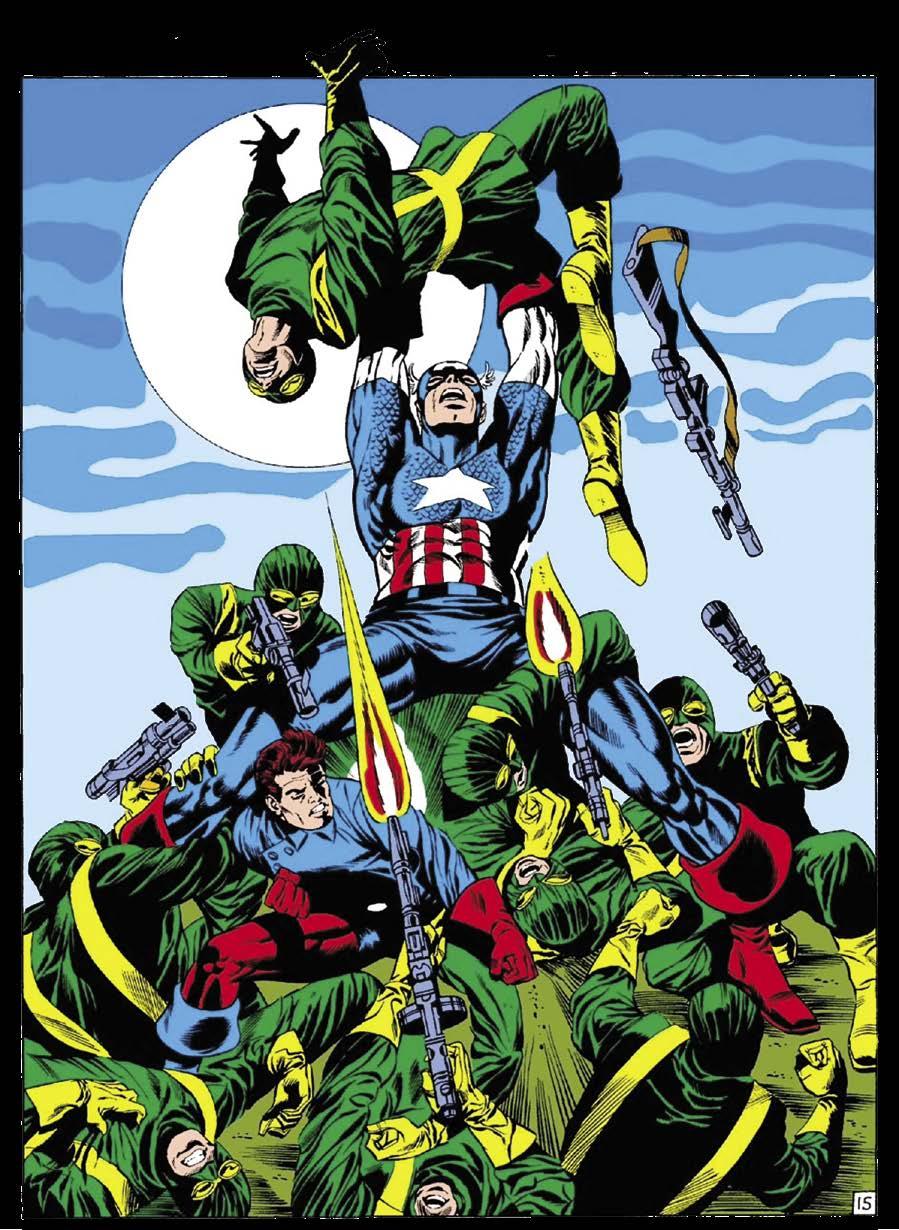
The Hordes of Hydra
It’s raining men—or is it hailing Hydra agents?
Detail from page 15 of the Steranko classic, Captain America #113 (May 1969).
TM & © Marvel.
Spies and P.I.s Issue • BACK ISSUE • 55
The Arms of Hydra
(top) From their first appearance in Strange Tales #135 (Aug. 1965), Hydra’s mission was clear. By Stan Lee, Jack Kirby, and Dick Ayers. (bottom) Hydra’s WWII roots began to unfold in Captain Savage and His Leatherneck Raiders #2 (Mar. 1968). Cover by Ayers and Syd Shores.
TM & © Marvel.
HYDRA VS . THE SILVER AGE
Spies were all the rage in the 1960s after the success of the novel The Spy Who Came in from the Cold by John le Carre, and motion pictures such as Dr. No and Goldfinger, starring Sean Connery as superspy James Bond. Never one to pass up on a popular trend, in Strange Tales #135 (Aug. 1965) Marvel gave Nicholas J. Fury, former leader of the Howling Commandos, a new position as the head of the top-secret spy organization the Supreme Headquarters, International Espionage and Law-Enforcement Division (S.H.I.E.L.D.). Much like Bond faced off against the terrorist criminal organization Special Executive for Counterintelligence, Terrorism, Revenge, and Extortion (SPECTRE), Fury was given his own terrorist organization to fight against.
Hydra, created by Stan Lee and Jack Kirby, made its debut in the same issue, even appearing menacingly on the cover. Some villains’ goals are to rob banks or jewelry stories. Not so with Hydra. Their goal is nothing short of total world domination.
Their mantra is as ominous as they are: “Hail Hydra! Immortal Hail Hydra! We shall never be destroyed! Cut off a limb and two more shall take its place. We serve none but the master as the world shall soon serve us! Hail Hydra!” When one falls, there are more to take his place and continue with Hydra’s devious plans.
Hydra’s initial storyline ran until issue #141 (Feb. 1966), but the multi-headed beast continued to return to face Fury and his cohorts in stories such as those in Strange Tales #151–157 (Feb.–Nov. 1966). Roy Thomas took over the writing duties from Lee with issue #153, before writer/artist Jim Steranko took over authorship of the title with #155. Thomas, who co-wrote #154 with Steranko, tells BACK ISSUE , “It was Jim Steranko’s intention with the story. I merely dialogued that story, at Stan’s request.”
The “Nick Fury, Agent of S.H.I.E.L.D” strip in Strange Tales was given its own title in 1968, and of course Hydra was there. Creators such as Thomas, Steve Parkhouse, Gary Friedrich, Frank Springer, Barry Windsor-Smith (then credited as Barry Smith), and Herb Trimpe continued to show the villainy of the terrorist organization.
“I just liked, from the outset, the concept of Hydra—its motto, etc.,” Thomas recalls. “The only thing I regretted was when Hydra took over S.H.I.E.L.D. That torpedoed interest in both for me. There needs to be an organization that duplicates S.H.I.E.L.D., but is evil—and Hydra naturally fits that bill. Great name, great concept.” And Roy shares this Hydra trivia with BI’s readers: “As shown in Alter Ego #176, there was a Hydra organization first in a Shadow story in Shadow Comics back in the late 1940s.”
Although Marvel’s Hydra was first seen in the Silver Age’s then-contemporary 1960s, the organization had been plaguing the world for far longer. In Captain Savage and His Leatherneck Raiders #2–4 (Mar.–July 1968) by Friedrich, Dick Ayers, and Syd Shores, Hydra was shown to be operating during World War II. The storyline revealed that the organization was formed by Baron Wolfgang von Strucker after he was ousted from the Nazi party by Adolf Hitler in Sgt. Fury and His Howling Commandos #29 (Apr. 1966). This origin would be retconned later in the post-BI era.

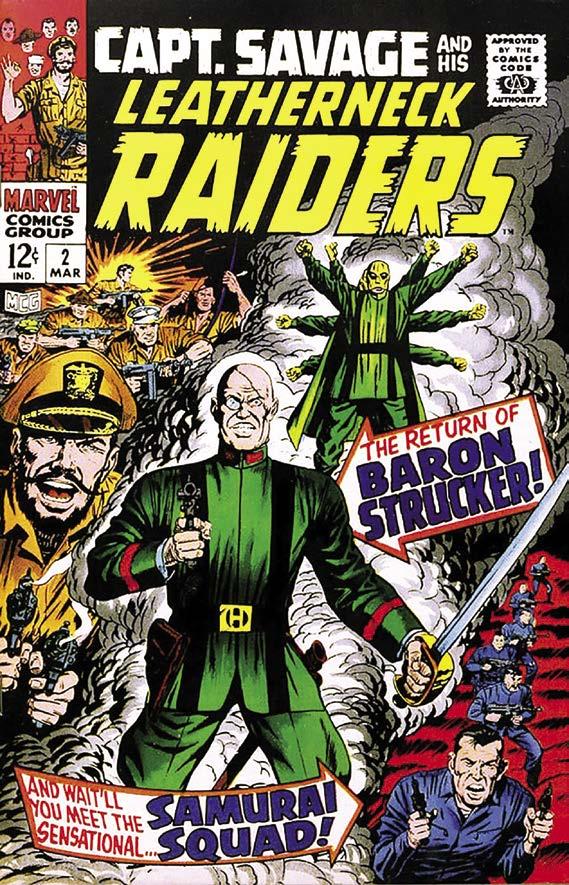
With the dawn of the Bronze Age, Hydra would take on more heroes in the Marvel Universe and show its true threat.
HYDRA VS CAPTAIN AMERICA
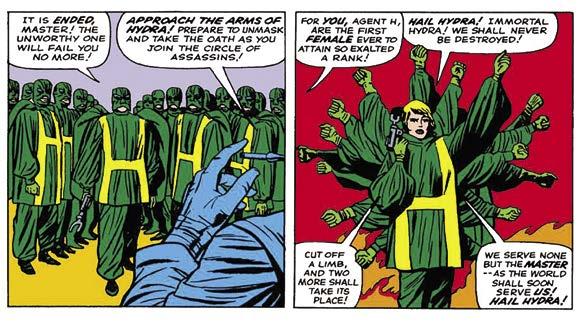
Captain America has been battling Hydra almost as long as Nick Fury. Writer/artist Jim Steranko and inker Joe Sinnott first brought Hydra into the pages of Captain America in a two-parter in issues #111 (Mar. 1969) and 113 (June 1969). Cap and Hydra continued to face each other during the Bronze Age and beyond.
Captain America #144–148 (Dec. 1971–Apr. 1972) detailed the wild twists and turns involving the identity of the Supreme
56 • BACK ISSUE • Spies and P.I.s Issue
roy thomas
© Luigi Novi / Wikimedia Commons.
Right away, I knew this comic was special. That tiny font of indicia, at the bottom of the inside front cover, normally commonplace and usually boring boilerplate, used wording that had never appeared before and probably will never appear again. It read: “JOHN LAW, DETECTIVE, Vol. 1 No. 1, April 1983. Published after 34 years in hibernation...”
Hibernation? 34 years? How could this be?
In the early ’80s, Eclipse Comics was publishing myriad fascinating and groundbreaking comics. Kitchen Sink was also publishing great comics, many with a focus on classic creators like Milton Caniff ( Steve Canyon ) and Will Eisner ( The Spirit ). So, it was a little surprising that Eclipse would publish a lost classic of Will Eisner’s featuring police detec tive John Law.
This 1983 comic, Will Eisner’s John Law, Detective #1, started off with a bang. The cover had Will Eisner’s inks over an unfinished penciled cover from decades before. The moody waterfront scene showed the hero interrupting a trio of seedy thugs, while a leggy femme fatale is about to surprise him—with a .45! With its gaudy colors by Klaus Janson, this comic certainly stood out on retailer shelves.
will eisner
The text piece within the comic pulled back the curtain on the proceedings. Editor catherine yronwode explained that while researching Will Eisner’s files, she came across the stat pages for a comic called John Law, Detective .
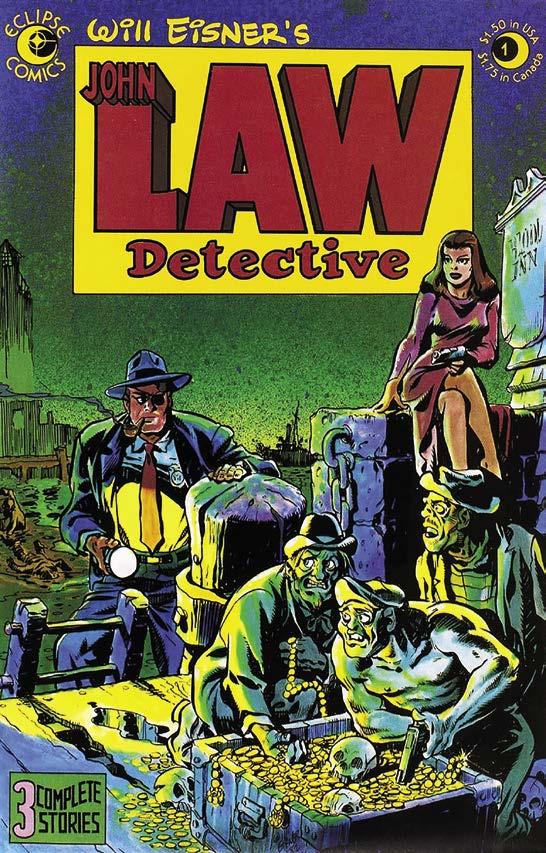
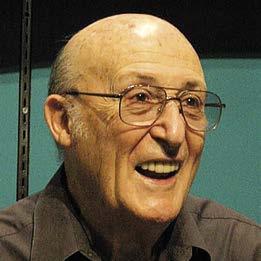
When she questioned Eisner about it, she explained in the text piece, he first replied, “Never heard of it.” But slowly he remembered the entrepreneurial efforts behind the creation of it.
Then yronwode continued relating her conversation with Eisner. Finally, he had an epiphany and recalled, “Oh, now I know! It was supposed to be the third of my self-published ventures, right after Baseball Comics and Kewpies. But they were a bomb, so I just put it away for a while.”
CROWDED PUBLISHING ENVIRONMENT
But these titles were not bombs, as Eisner put it, due to “poor quality.”
Denis Kitchen is a cartoonist, publisher, entrepreneur, and an agent for the Eisner estate, and he explains to BACK ISSUE how, back in the late ’40s, “newsstands were clogged with comics from other publishers. Even if Lev Gleason’s Crime Does Not Pay did not really publish at the levels they said, there were still a lot of comics out there. 1949 was cluttered: Crime Does Not Pay , Superman , Captain Marvel [Adventures]—too many titles.
“Will couldn’t have picked a worse time to launch a new comic series.”
In retrospect, Denis makes an interesting point. He wonders if it was a misstep (on Will Eisner’s part) to lead the 1949 effort with Kewpies and Baseball Comics and not John Law, Detective and the fourth title that Eisner had planned, Pirates
“He went for the young market (instead of crime and pirate comics), and that may have been a mistake. I’m not sure why he rolled the dice with those two,” ponders Kitchen.
CLASSIC NOIR
A Treasure Chest
The cover of Will Eisner’s John Law, Detective #1 shows criminals pawing through an overstuffed treasure chest. This might have been a metaphor for the actual comic.
In addition to yronwode’s text piece, this comic presents three short stories. One of which, many would claim, is one of the greatest Spirit stories from one of the greatest comic creators.
Spies and P.I.s Issue • BACK ISSUE • 67
Patty Mooney / Wikimedia Commons.
Will Eisner’s John Law, Detective, #1 (and only), coverdated April 1983.
© Will Eisner Studios, Inc.
by Ed Catto
Not content with exposing the secret British missions of S.H.I.E.L.D. in this issue, the shadowy figure that is Ian Millsted investigates the agency known as Checkmate. It’s all very hush-hush, give or take the odd explosion.
The series, Checkmate! , (the exclamation mark was part of the name of the comic series but I’ll dispense with it when talking about the agency) had its roots in two other titles released shortly before Checkmate! #1 (Apr. 1988) hit the stores.
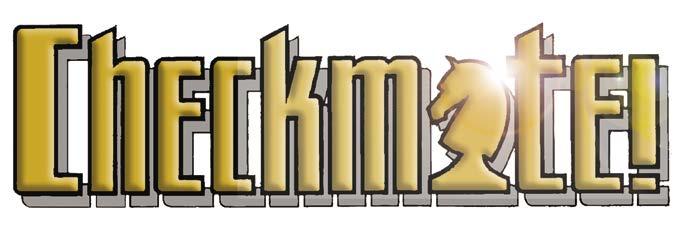

Firstly, several of the characters had been supporting cast members in the series Vigilante, which ended with its 50th issue (Feb. 1988), as well as the structure of a government agency using those with “special skills” to take direct action against terrorist, and similar threats. The main character in Vigilante was Adrian Chase, who had first appeared in The New Teen Titans by Marv Wolfman and George Pérez. The 50 issues of the series were full of tough action and themes, acquiring a “mature readers” label during its run [see BI #102—ed.]. Chase sometimes worked for Harry Stein, a govern ment agency chief, and his deputy, former Gotham City detective, Harvey Bullock. The former Charlton Comics character the Peacemaker (now familiar to modern film audiences of The Suicide Squad and subsequent Peacemaker television series on HBO Max) also worked for Stein. Chase’s story ended in tragedy and contro versy, but the background world in which the stories had been played out would continue in Checkmate!
However, not before an appearance in Action Comics. At this time Action Comics had become a Superman team-up title and #598 (Mar. 1988) featured the first named appearance of Checkmate . Paul Kupperberg and John Byrne co-plotted, with Kupperberg scripting and Byrne drawing, alongside Superman fighting against villainous terrorists, the Jackal and the Angels of Allah. As well as Stein and Bullock we have our first sighting of the uniformed Checkmate agents, in this case Knight Two. As the name suggests, the agents are based on chess pieces, and also fully masked with their real identities only shown as and when it suits the needs of the story. The first issue of the regular series followed a month later.
Checkmate! #1 opens like a big-budget action movie of the era (think Die Hard or similar). The first three pages, depicting a real-world Chicago down town, are finely detailed and show three separate acts of bravery and a big explosion—the first of many. The scene shifts to New York, where Harvey Bullock and two unnamed agents capture former Vigilante ally Black Thorn. Next it’s off to Virginia, where Amanda Waller (from Suicide Squad) is in talks with Harry Stein. This scene serves as dramatic exposition to explain some of the structure of the Checkmate organization. Harry Stein is the King, running Checkmate, while Waller is Queen, operating above Stein as governance, but not involved, at this stage, in the day-to-day operations.
Hop on Here!
Kerry Gammill and Karl Kesel’s highoctane cover to DC Comics’ super-spy series, Checkmate! #1 (Apr. 1988), featuring Knight Gary Washington.
TM & © DC Comics.
70 • BACK ISSUE • Spies and P.I.s Issue
TM
by Ian Millsted
THE FIRST ‘CHECKMATE’ COMIC BOOK
Here’s some BACK ISSUE trivia you didn’t know you need to know! Western Publishing, under its Gold Key Comics imprint, published two issues of Checkmate in 1962. The comic was an adaptation of a stylish television drama about a San Francisco–based private-investigation agency named Checkmate, Inc. Anthony George, Doug McClure, and Sebastian Cabot starred. Checkmate ran on CBS for two seasons (1960–1962). Both issues of Gold Key’s Checkmate featured photo covers and interior artwork by Jack Sparling. – Michael Eury
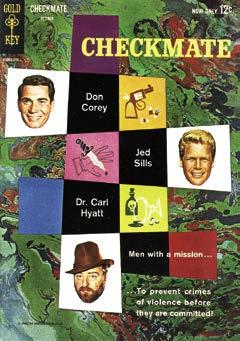
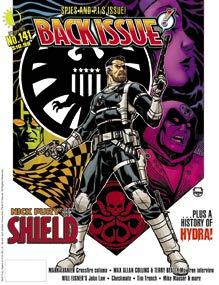

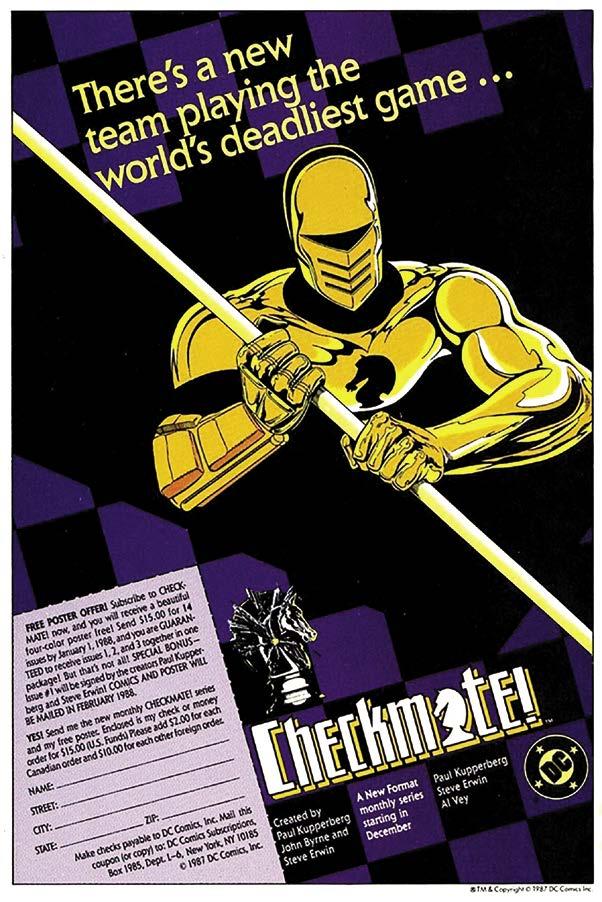
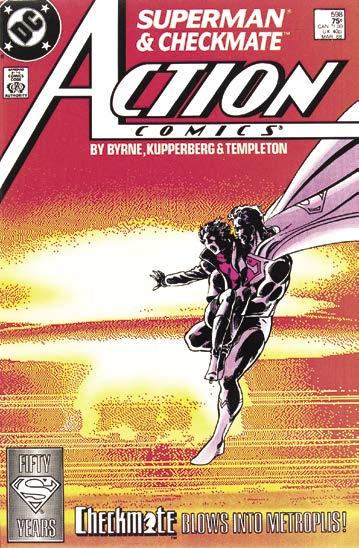
Bishops, including Harvey Bullock, are the chiefs, operating under the King. Knights are field agents. Rooks are field directors. Pawns are support personnel. Finally, we see an extended, and well executed, action sequence in which a Knight rescues a hostage from the white supremacist group responsible for the explosion on page three. Two other events of interest are another explosion, bookending the issue, and the reveal of the skin color of the Knight tackling the white supremacists. Paul Kupperberg, John Byrne, and Steve Erwin are given a collective creator credit. Along with Kupperberg (writer) and Erwin (pencils), Al Vey does fine work on the interior inks, and the cover is by the team of Kerry Gammill and Karl Kesel. Also worth noting is that, while the title does not carry a “mature readers” tag as Vigilante had done, it does not have the Comics Code seal and therefore operates, as several DC titles did at the time, in the gray area between.
Artist Steve Erwin shares with BACK ISSUE how his involvement in the series came about. “That’s a chain of events. It started with my being hired by DC [group] editor Mike Gold to be the new pencil artist on Vigilante, one of his stable of titles. I was not aware at the time that I would be drawing the final three issues of that title, as it was slated for cancellation. Mike and Paul (who was writing Vigilante) met me at Chicago Comic-Con, and we had a (I swear this is true) clandestine meeting where I was sworn to secrecy. We discussed a) ’s cancellation, b) Adrian Chase’s demise in the final issue, and c) Checkmate! being the replacement title on the publishing schedule. I couldn’t tell anybody about how Vigilante was going to end—it was the ultimate secret at the time. I was asked to not even divulge anything about it to my wife. (It was okay to mention Vig was being cancelled and that I would be drawing the replacement title, but beyond that… nope.)
“Paul had done all the heavy lifting on Checkmate! by this point: the general concept, the main cast members, that sort of thing. My job was to bring the book to visual life, so I got
An Explosive Premiere
(top) Checkmate’s logo lacked its exclamation point on this John Byrne cover to the group’s series-launching team-up with Super man in Action Comics #598 (Mar. 1988). (This issue is also known for its cover’s unfortunate typo of “Metropolis.”) (bottom) Checkmate! house ad, with a subscription form.
P.I.s Issue • BACK ISSUE • 71
Spies and
TM & © DC Comics.
IF YOU ENJOYED THIS PREVIEW, CLICK THE LINK TO ORDER THIS ISSUE IN PRINT OR DIGITAL FORMAT! BACK ISSUE #141 SPIES AND P.I.s! Nick Fury from Howling Commando to Agent of S.H.I.E.L.D., Ms. Tree’s MAX ALLAN COLLINS and TERRY BEATTY in a Pro2Pro interview, MARK EVANIER on his Crossfire series, a Hydra villain history, WILL EISNER’s John Law, Checkmate, and Tim Trench and Mike Mauser. With ENGLEHART, ERWIN, HALL, ISABELLA, KUPPERBERG, STATON, THOMAS, and cover by DAVE JOHNSON! (84-page FULL-COLOR magazine) $10.95 (Digital Edition) $4.99 https://twomorrows.com/index.php?main_page=product_info&cPath=98_54&products_id=1672
steve erwin
Facebook. © Jamco Productions.

































 Guest columnist Mark Evanier recalls the fun he had co-producing Eclipse Comics’ Crossfire series in the 1980s. Crossfire #3 (July 1984) cover by Dan Spiegle.
Guest columnist Mark Evanier recalls the fun he had co-producing Eclipse Comics’ Crossfire series in the 1980s. Crossfire #3 (July 1984) cover by Dan Spiegle.
















